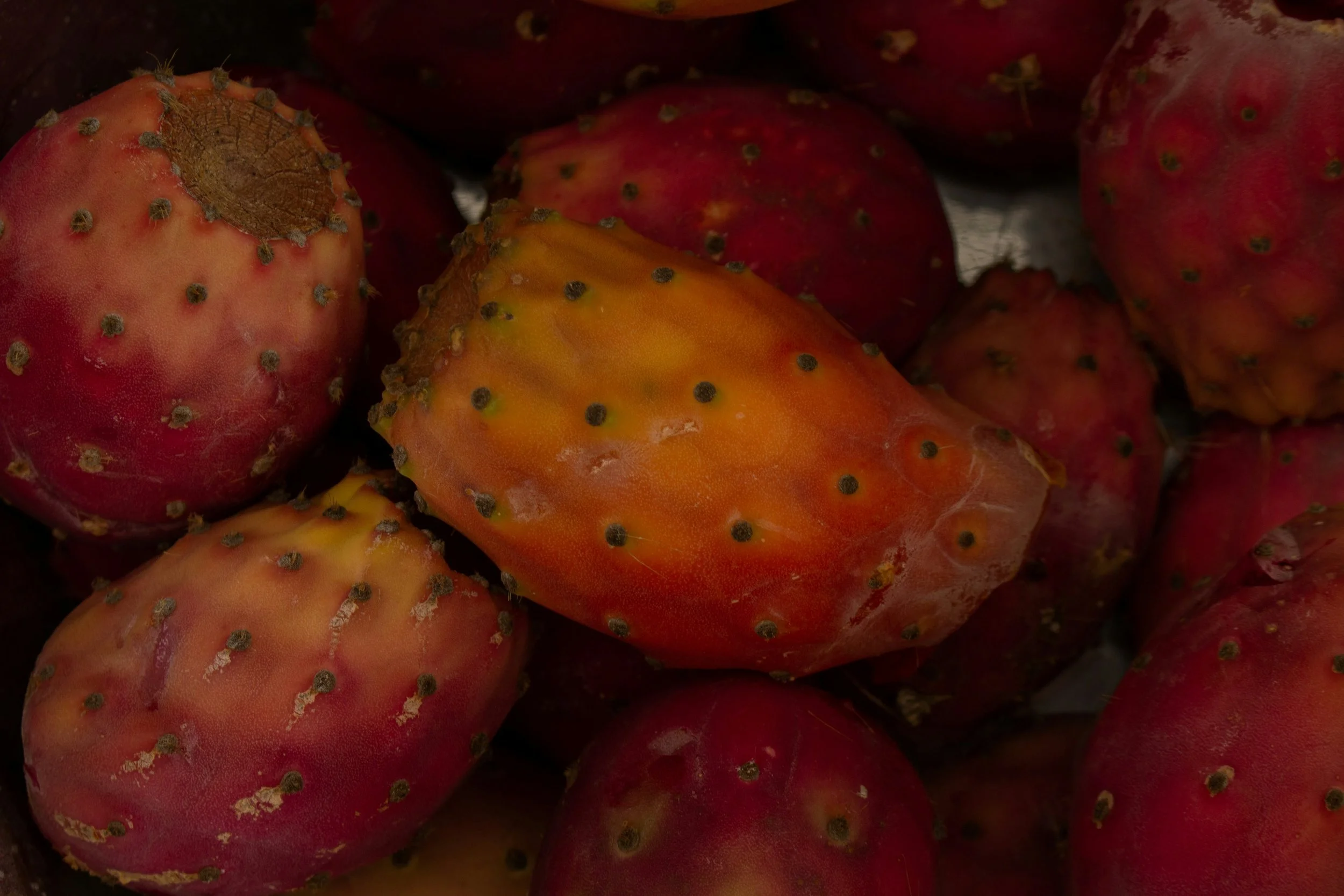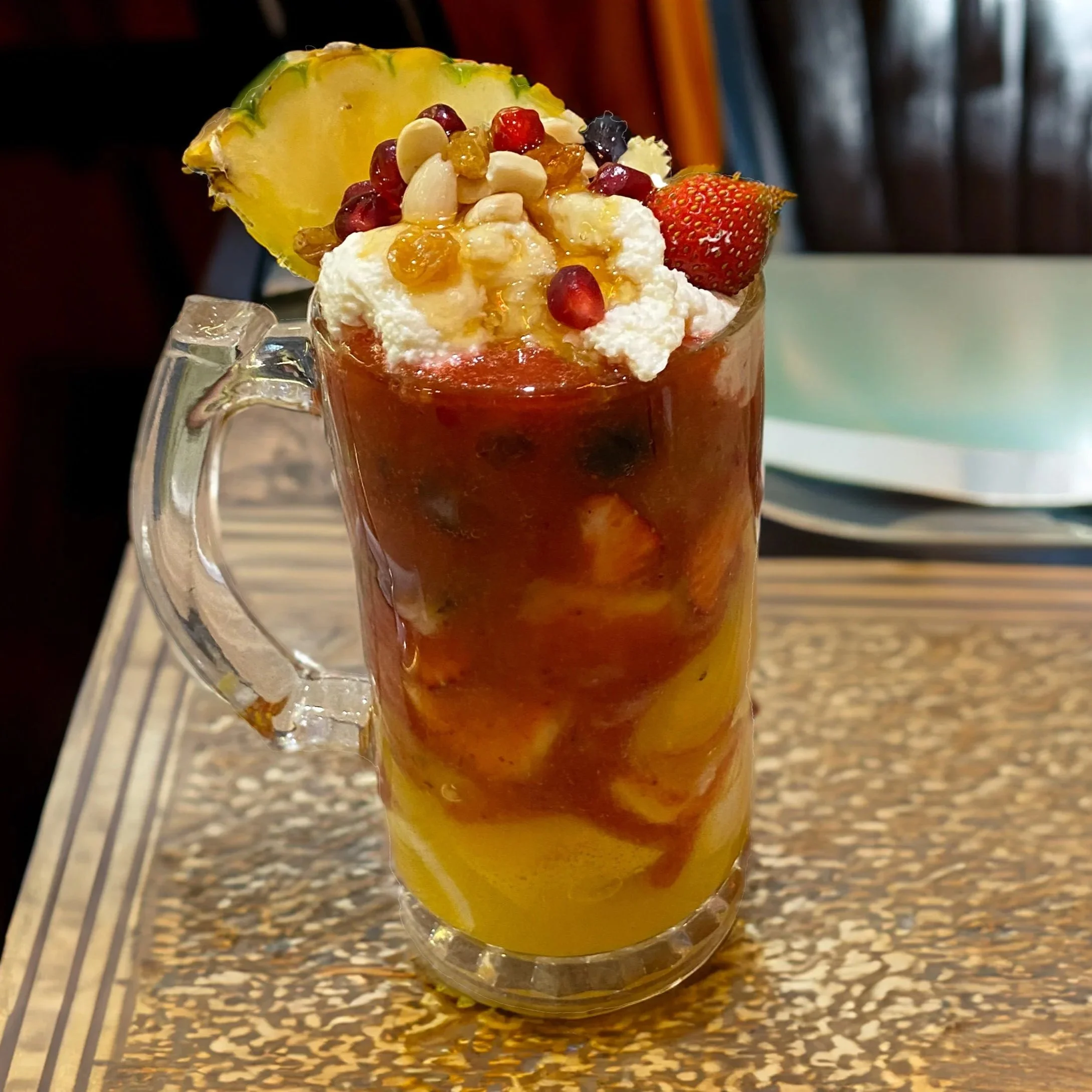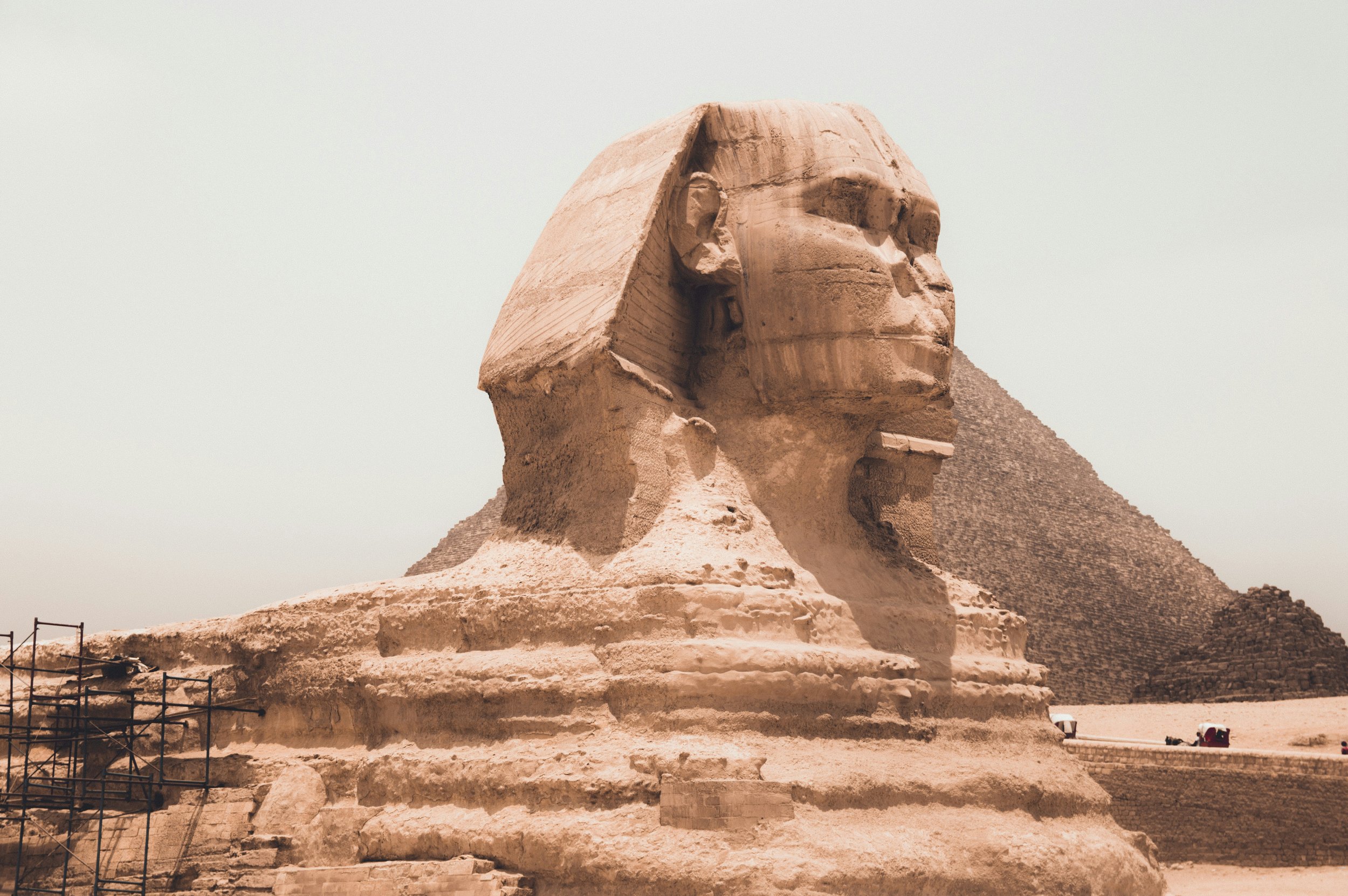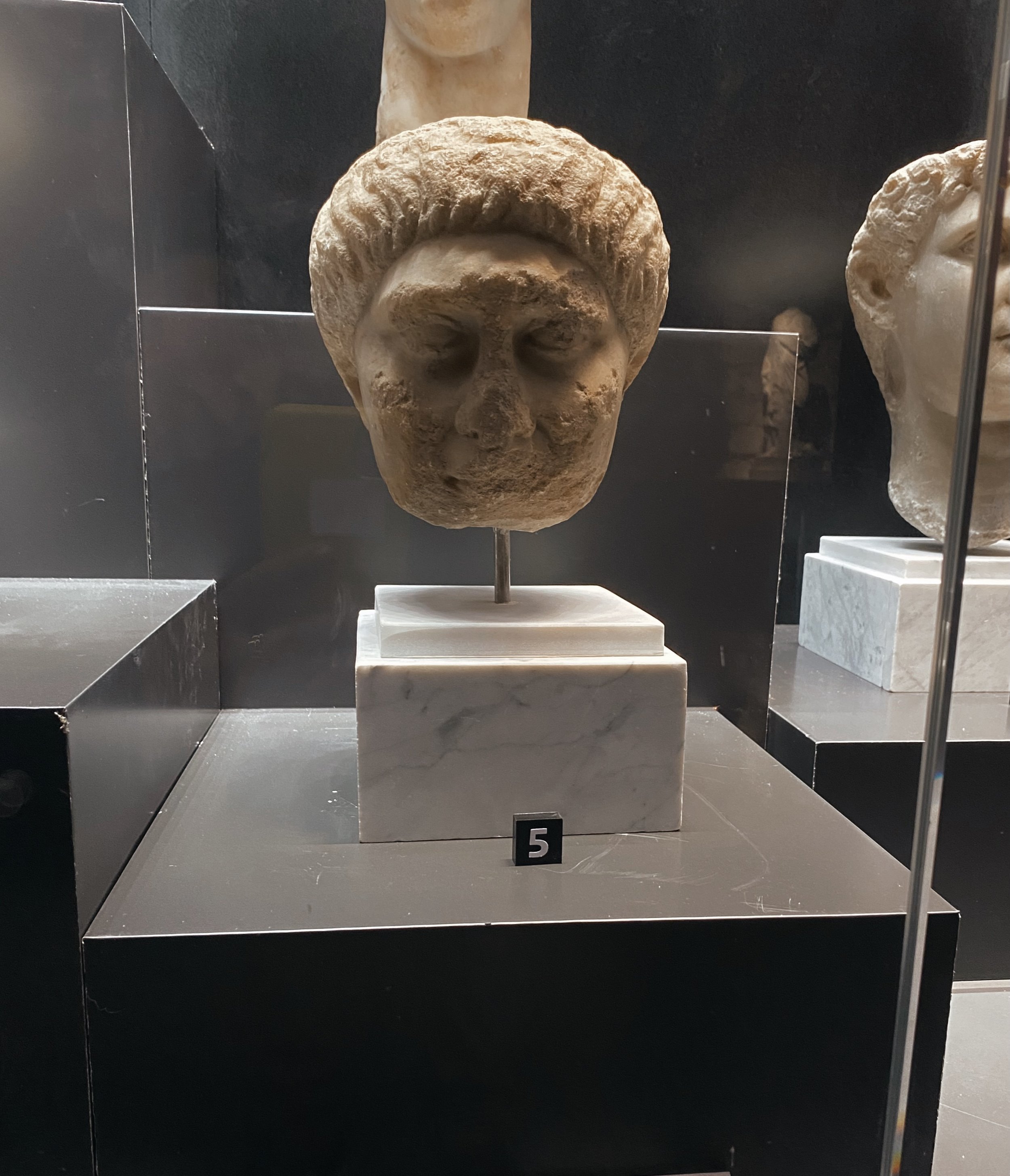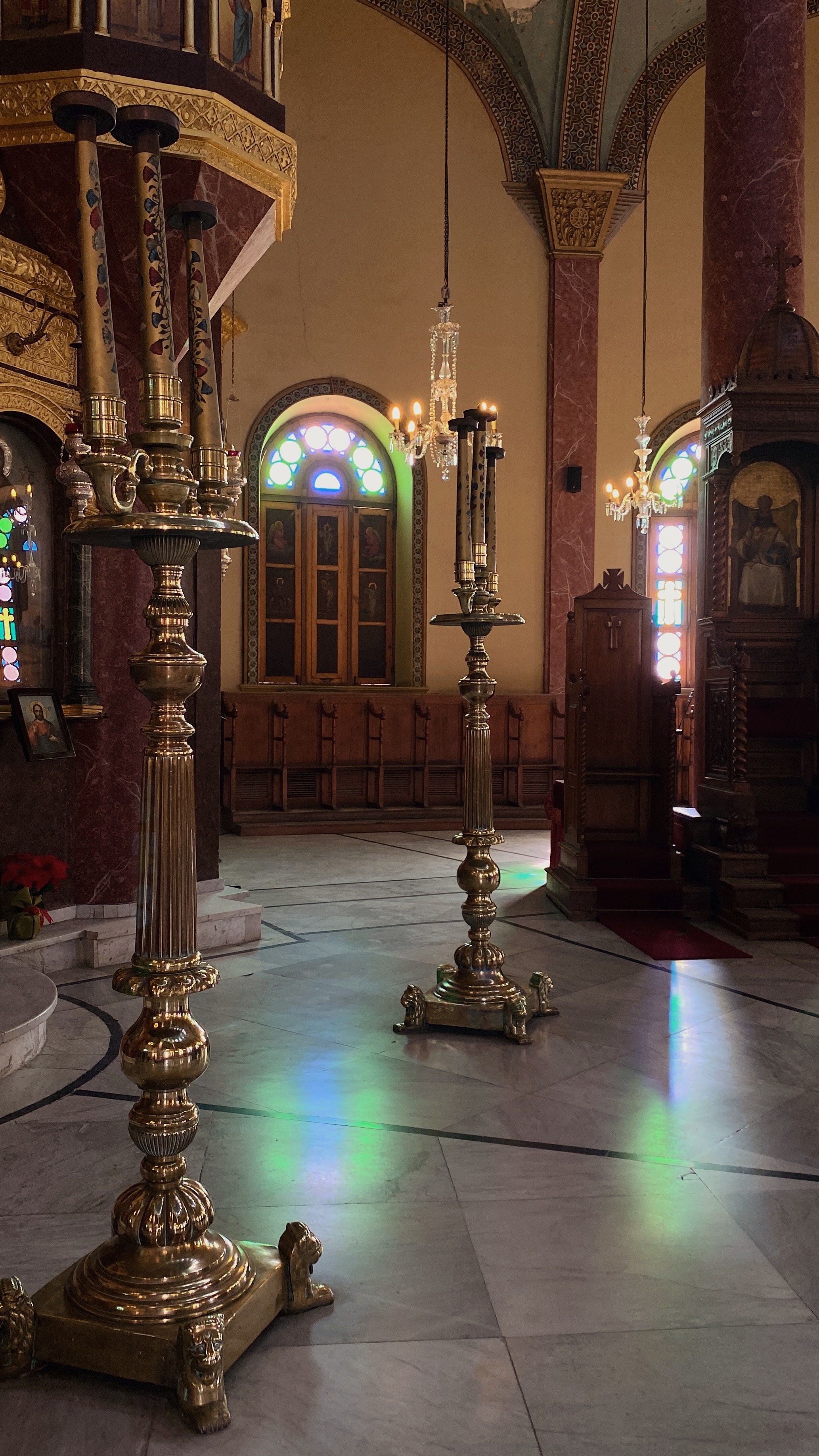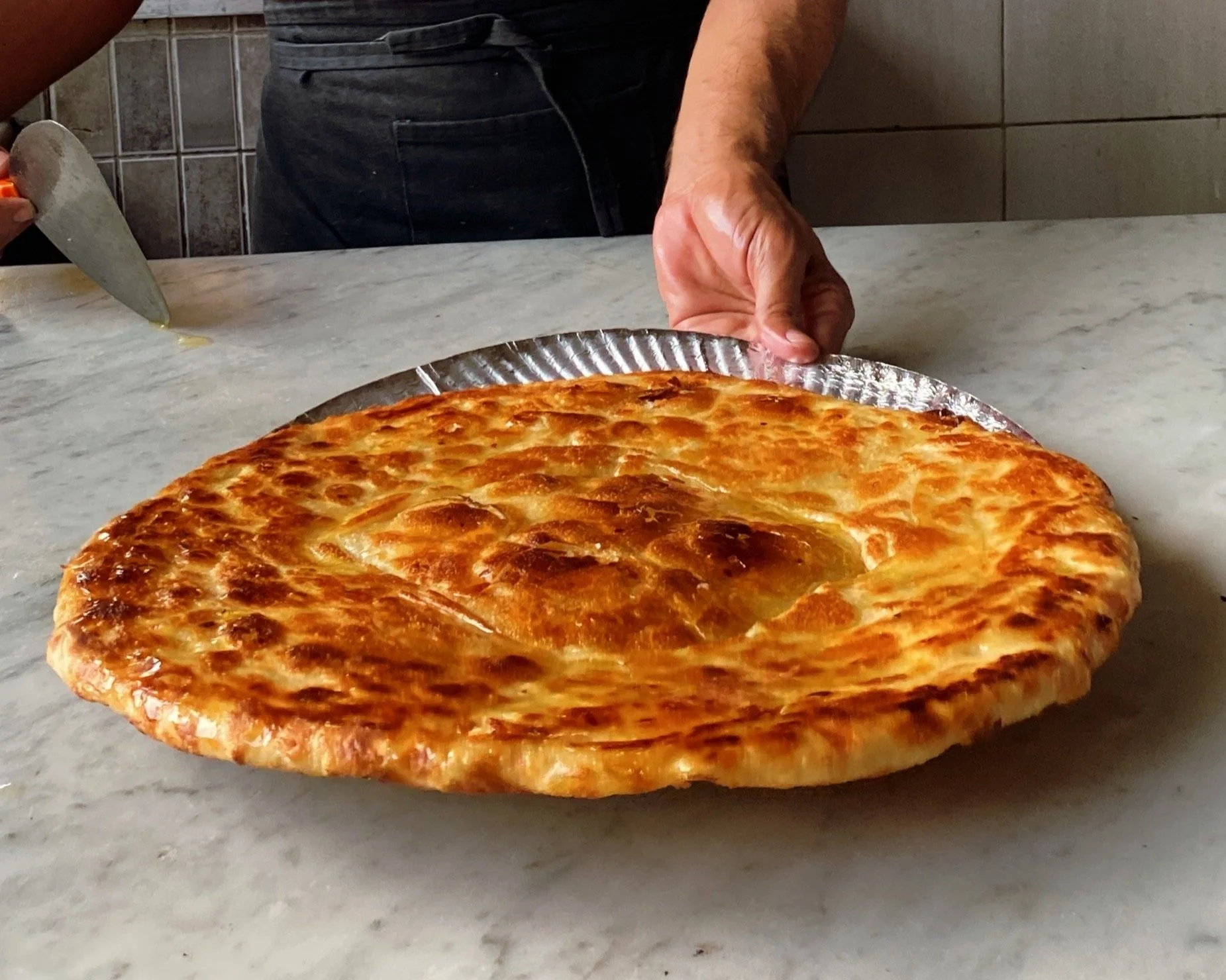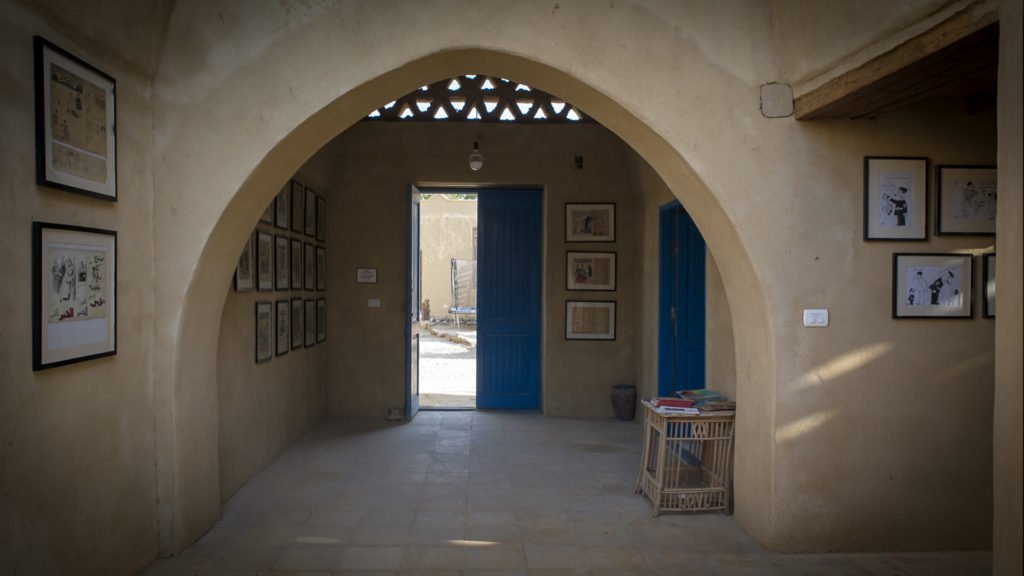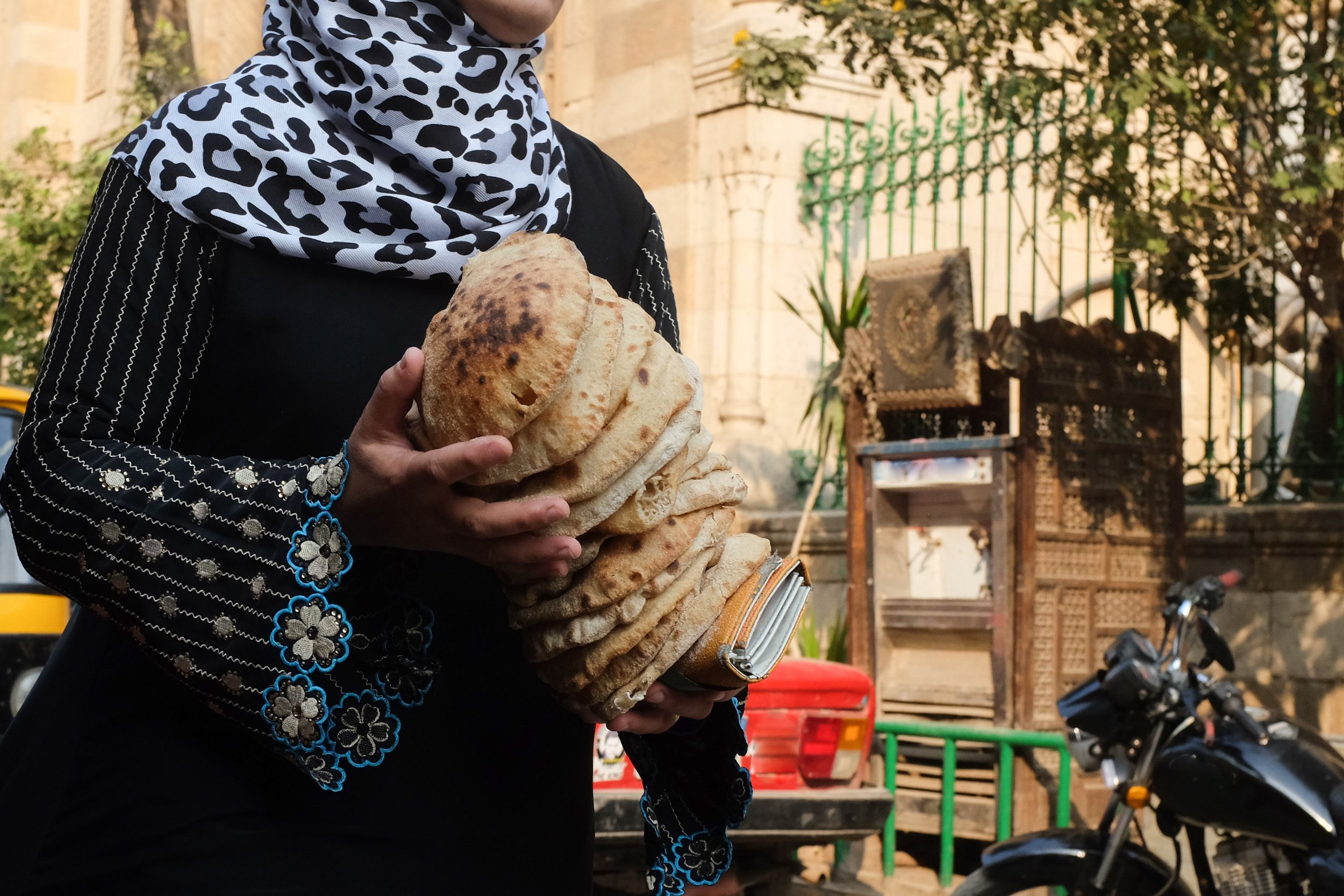
Egyptian Summer Dishes: What to Eat in Egypt When the Heat Hits
It can get hot, very hot in Egypt! So what do locals eat when temperatures soar and even the thought of a hot oven makes you sweat? The Bellies team rounded up a list of Egyptian summer favorites. Some are served cold, others are super hydrating, and all just hit the spot when you’re looking for something light and satisfying.
Here’s what to look out for if you’re eating your way through Egypt in the summertime.
Koshary – Egypt’s National Dish All Year Long
You probably guessed this one. Koshary is Egypt’s ultimate comfort food and street food staple. It’s made with pasta, rice, lentils, chickpeas, and crispy onions, all topped with a vinegary tomato sauce. Surprisingly (and unlike a ragù bolognese), Koshary tastes just as good at room temperature, which makes it a perfect meal in the summer heat. Add a cold soda on the side, and you're set. You do, however, want to make sure you eat Koshary indoors during the summertime, opt for an air-conditioned restaurant, not an open-air joint for this dish.
You can learn how to make your own Koshary at home with our e-cookbook , get 30% off with code KosharyTime.
Bissara – A Light, Vegan Egyptian Breakfast, Lunch, or dip
This humble dish doesn’t get nearly enough love. Made from blended fava beans cooked down with herbs, garlic, and greens, then topped with crispy fried onions, Bissara is usually served cold or at room temperature with bread. Light, earthy, and comforting — it’s a typical Egyptian lunch during the warmer months. The flavors of the fresh greens, which can include mint and cilantro, elevate the flavor and density of the fava beans, making it a bright mezze you don’t want to miss.
Bissara isn’t very common to find in restaurants, most locals make it at home. However, we absolutely love the Bissara served at Five Bells (Zamalek) and Zeeyara (Giza & Old Cairo). Order a round of mezzes at either restaurant, and tie them all together with local balady bread; you can even ask for your bread to be crisped up.
Bissara with fried onion and garnish
SALATET Ringa – Smoked Herring Salad with a Zing
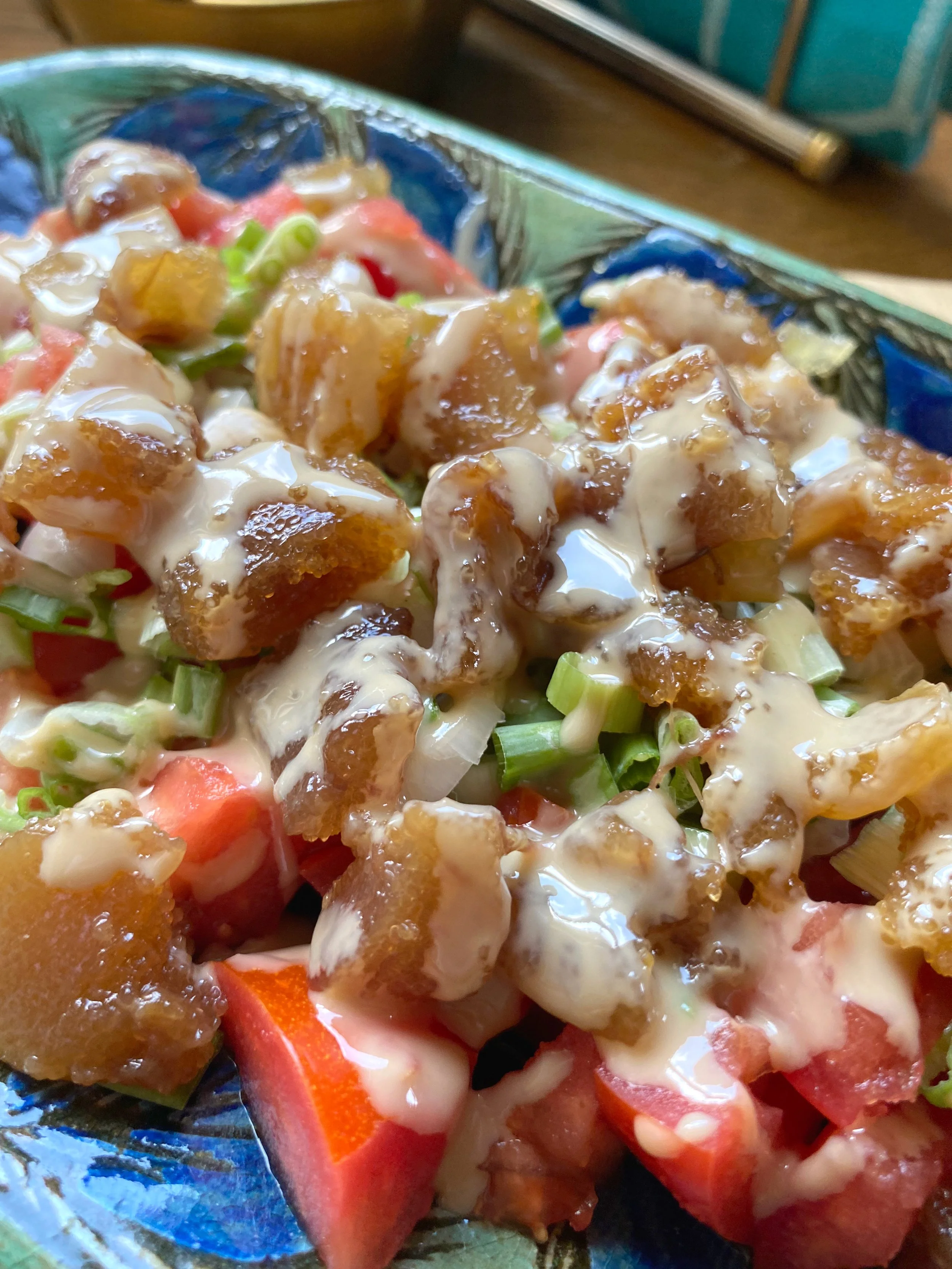
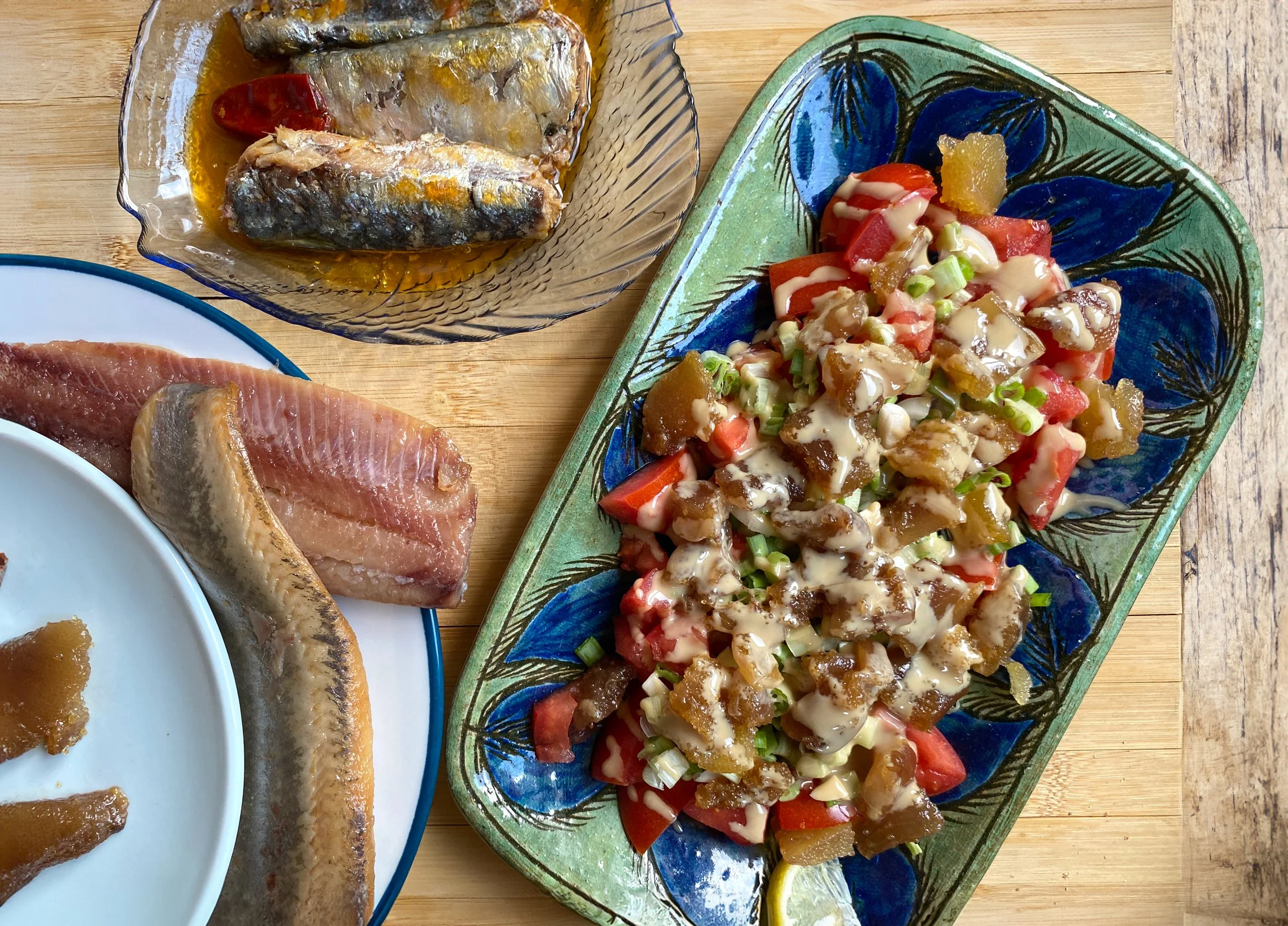
Smoked herring might not scream "refreshing," but Egyptians know how to make it summer-ready by turning it into a well-balanced salad. The fish is chopped with green onions, lemon juice, and tehina or vinegar, alongside other vegetables like tomatoes and peppers, essentially making it gentler in flavor. While still more appealing to those who enjoy bold flavors, ringa is worth a try when consumed as a vibrant salad. Add some bread on the side and you’re definitely eating a dish that you won’t find elsewhere.
Betingan Mekhalel – Pickled Eggplant
Egyptians are blessed with a variety of eggplants, to us, they’re the gift that keeps on giving. From restaurant tables to homes, pickled eggplants are a staple that’s often over-looked by tourists. A tangy eggplant dish you’ll usually find on any Egyptian mezze table. Slices of petite fried eggplants are soaked in a spicy, garlicky, tomato and vinegar sauce, alongside any/all meals, they are served cold or at room temperature with bread. The vinegar gives it that refreshing kick perfect for hot weather. This dish isn’t talked about enough, because it’s a companion we take for granted, until of course we take that first succulent bite.
Watermelon & White Cheese – Egypt’s Favorite Summer Combo
Simple but genius: cold cubes of sweet watermelon served with salty Egyptian gebna beida, a feta-style fresh cheese and a staple no true Egyptian home can go without. While typically eaten with sen bread as a light/late dinner or snack, it pairs perfectly with our brilliant red melons. This is a go-to Egyptian combo that’s not only refreshing, but also easy to put together in under a minute. So when bateekh (watermelon) season hits, get yourself some white cheese because this one will win you over after a long day of sightseeing.
Mango – The Star of Egyptian Summer Fruits
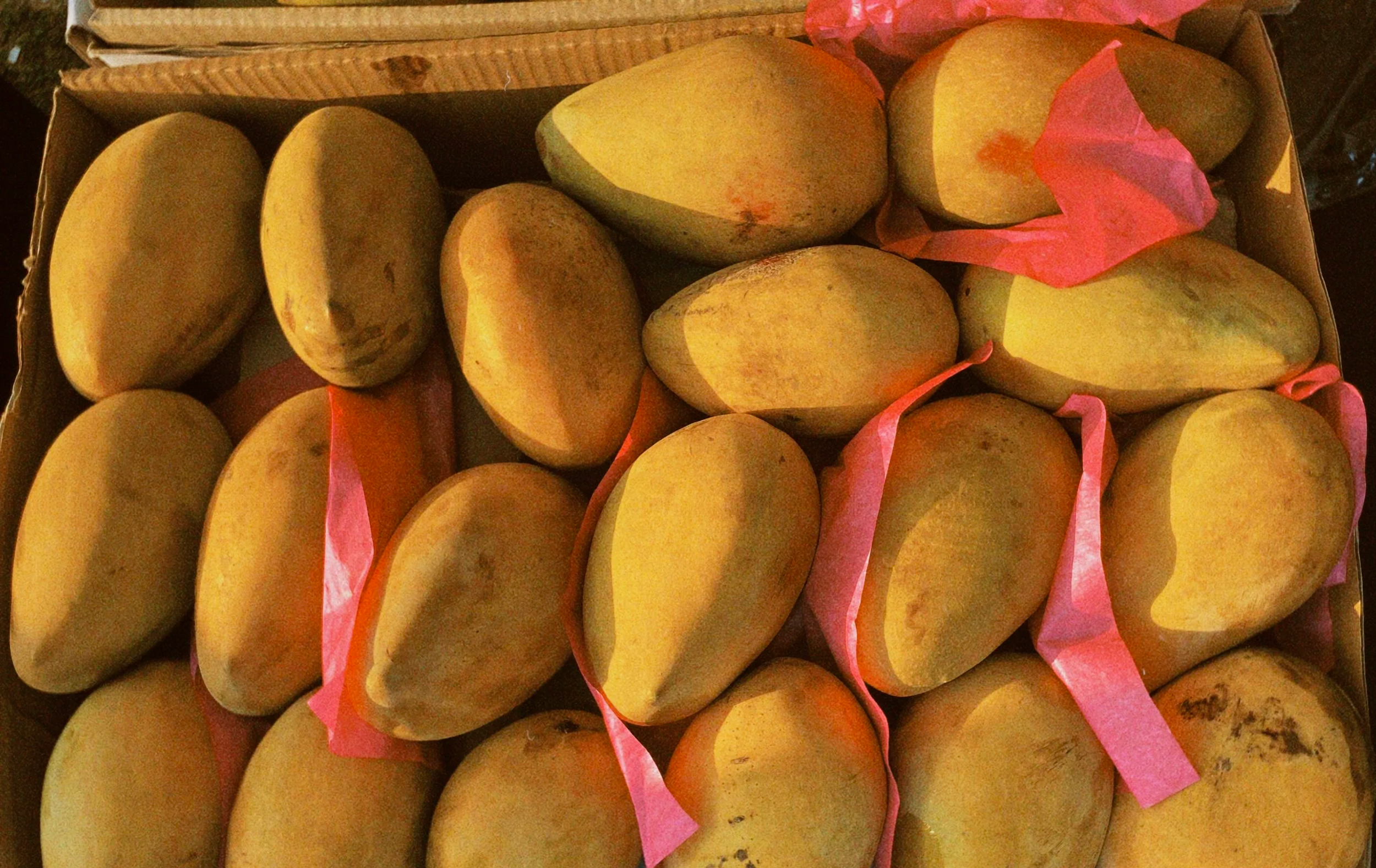
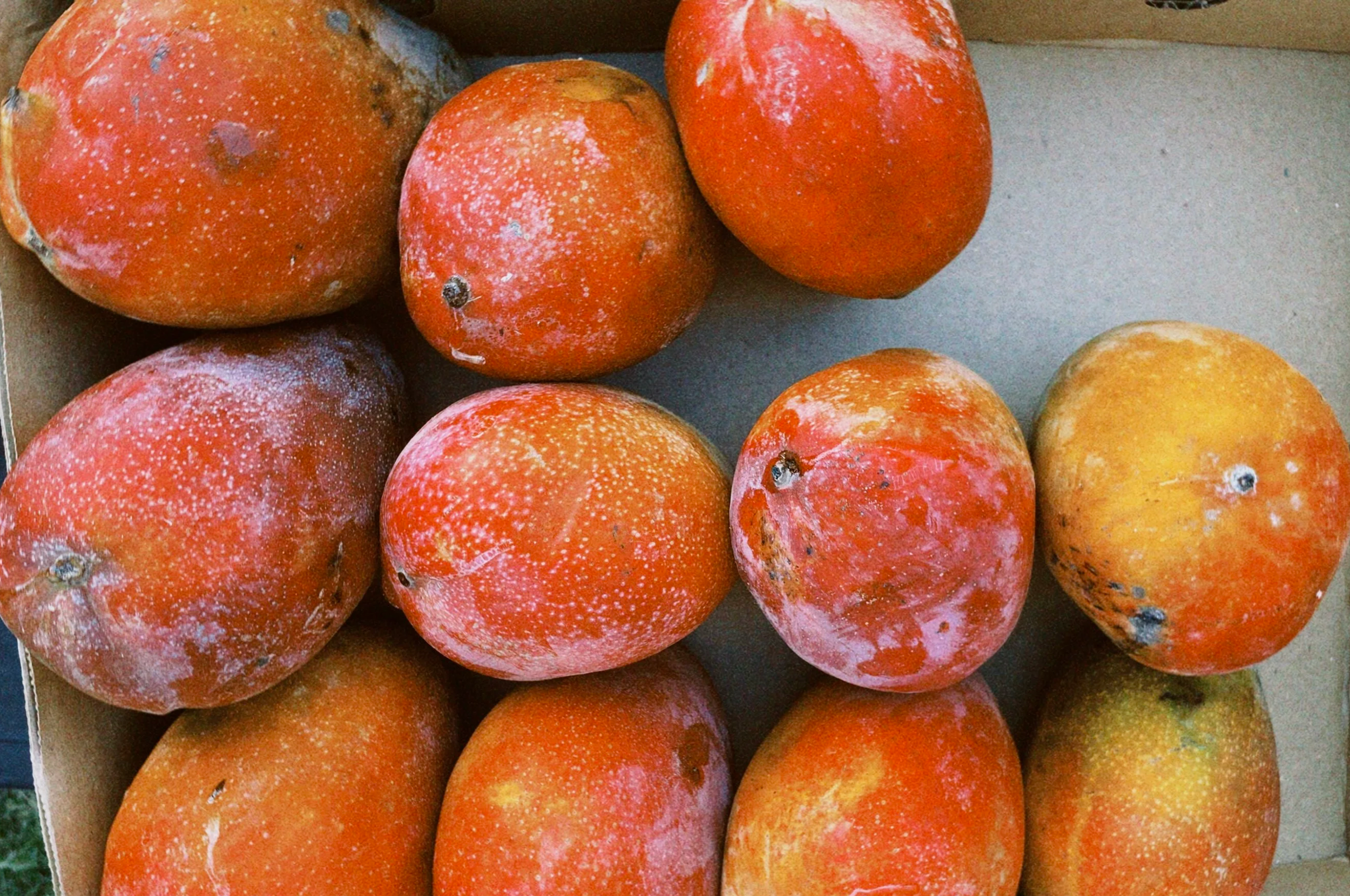


Between July and September, Egypt lives for mangoes. You’ll find mango juice shops on every corner, vendors selling crates of fresh mangoes, and restaurants offering mango ice cream or desserts. With tons of varieties to choose from, some of our teams’s favorites are Oweis, Taymour and Fons (short for Alphonso). Mangoes are so beloved in Egypt, and with such a short season, some farms sell out even before harvesting begins. We also have our own mango festival that takes place every August in Egypt’s mango capital, Ismailia.
Watch the Bellies En-route team tackle mangoes
Teen Shooky – Chilled Cactus Fruit on the Go
Come summer and you’ll find an abundance of prickly pear street carts lining the streets all over Egypt. Known as teen shooky in Egypt, this colorful fruit is a quintessential summer experience on every street corner. To get a taste of it yourself, stop at a cart, and the seller will happily and swiftly peel one (or many) just for you. As you enjoy this (slightly) sweet, hydrating, and fiber-packed fruit, keep in mind that that it’s full of the tiny seeds you don’t want to chew, instead simply let them slip through as you eat, they’re totally safe to consume.
Karkade – Iced Hibiscus Tea to Cool Down
One of the most iconic Egyptian drinks, karkade is made from dried hibiscus petals brewed and chilled, then sweetened to taste. It’s naturally cooling, packed with antioxidants, and great for staying hydrated in the heat. If your trip takes you to Aswan, we recommend buying dried hibiscus from there (peanuts too!). Don’t despair if you’re only visiting Cairo though, you can still find dried hibiscus petals in spice shops all around the city. You can even buy hibiscus tea bags and consume them hot or cold when you’re back home.
Fakhfakheena – Egypt’s Ultimate Summer Fruit Salad/Drink
This isn’t your average fruit salad. Fakhfakheena (pronounced fakh-fakh-eenah) is a layered assortment of ingredients that are as fun as its name. You’ll commonly find a mix of seasonal fruits, fresh juice, scoops of ice cream or cream and sometimes a sprinkle of nuts in your massive glass. It’s cold, colorful, and indulgent, just like you want a summer dessert to be. Locals love it, and if you have a sweet tooth, then so will you!
The Bellies team recommend you try it at El Sharbatly in Downtown, Cairo.
Looking for more authentic dishes and culinary experiences in Cairo?
As you brave the summer heat (hats off to you), join one of our evening tours or learn to cook in our (air-conditioned) kitchen space and discover how locals eat, even when it's 40°C out! From local favorites and hands-on workshops to female-owned gift shops and market tours, we’ll take you off-the-beaten-path in Cairo. Book your spots now, we can’t wait to eat with you!
6 Must-Try Breads in Cairo
In Egypt, bread is eaten with every meal and is generally considered the most important part. In other words, it’s a food staple- that means that most people don’t think a meal is complete without some form of bread!
In Egypt, bread is eaten with every meal and is generally considered the most important part. In other words, it’s a food staple- that means that most people don’t think a meal is complete without some form of bread! Historically, bread has always been baked at home by the women of the family- and it’s largely a communal activity. In modern times, home baking isn’t quite as popular as it once was (at least in Cairo), and that’s where bakeries come in! Balady bread is one of the subsidized foods the government provides for those who need it. We take our bread very seriously and have had major political unrest in the past over shortages.
Egypt boasts a wide variety of local breads with long and significant histories. Cairo (and Alexandria’s) bread scene is a little different because of strong European influences. Many of the breads found in bakeries across the capital are of European origin- but with a significant Egyptian twist! Which makes things quite interesting. Here are 5 breads we recommend you try on your next trip to Cairo. Pick up some white cheese, roomy cheese, halawa- and get to snacking!
Balady Bread
Balady bread is the king of Egyptian breads in Cairo. The word “balady” literally translates to “my country”, but we use it to say: of the land, rural, Egyptian, and authentic. This bread is a pocket loaf, perfect for sandwiches, and even better for scooping foods and mopping up sauces. It is by far the most popular bread in Egypt and is versatile enough to be eaten at every meal. What makes this bread so special is its two textures: the top part of this pocket bread is thin and when heated can become crispy, which is great for scooping and pinching morsels of food. The bottom part is thicker and more textured, ideal for absorbing sauces. It’s base is coated heavily in wheat bran, so it leaves a trace wherever it goes. This bread is eaten for its great taste, but also used as a utensil to pick up food. Ideally, balady bread is heated on an open flame- never eaten at room temperature, if it can be avoided, giving it a slight smokey flavor and crisp texture. You can find balady bread at any supermarket, and most bakeries.
Shamy Bread
Guillaume Paumier, CC BY 3.0
Shamy bread is similar to balady, just whiter and sweeter! It’s a round pocket bread, with thinner smoother walls, (unlike balady, which is grooved and textured), and made purely of white flour. It is not baked as dark as balady, and doesn’t have any burn spots. Shamy is made very thin or quite thick, depending on its use.
The word “shamy” means “from the Levant”. So it can be assumed that this kind of bread has its origins from the Levant area, that being said- it has been heavily Egyptian-ized to suit our taste. Eaten in a similar way to balady, shamy is used for sandwiches and to grasp bites of food- however it’s not nearly as popular as balady. You can find shamy bread at almost all supermarkets and certain bakeries.
Fino Bread
Fino (pronounced “fee-no”) is the childhood bread of all Egyptians! It’s a sweet, fluffy, soft elongated bread roll that is used for school sandwiches. Children across Cairo eat fino sandwiches at recess everyday, and here are the top fillings: cheese, jam, halawa (known internationally as halva), and cold cuts. Bakeries in residential areas will often bake fino in the evenings, as that is when parents come by to pick up bread for their kid’s school lunches!
It comes in all sorts of sizes, from thinner than a slice of roomy cheese, (that’s pretty thin- think 5cm/2 inches), to thicker than a hotdog bun! Each size has a specific use- thin ones for cheese and sweet fillings, while thicker are used for heartier fillings such as chicken. Fino can be found at all large supermarkets and most bakeries.
Bellies recommend: Kebda Awlad El-Fallah, a popular liver sandwich shop that uses fino bread! This is s common way to serve liver. There are many branches of this restaurant across the country, but this Alexandrian location is the original!
Alexandria’s fino bread, the skinner sibling of Cairo’s fino bread.
Sen Bread
Even when dieting, Egyptians don’t cut out bread! They just swap it out for a healthier version and that’s where sen bread comes in! It’s a high bran bread, with very little actual flour. Its most popular form is a puffed up pocket bread- like pita, but it’s completely hard like a cracker! Chock full of protein and fiber, it’s much more nutrient dense than breads made of white or whole wheat flour. It goes by the name of ” ‘eish regime”, or diet bread (“regime” being the French word for diet). Sen bread usually accompanies any kind of healthy meal instead of balady bread.
Oras
Oras (pronounced : oh-rus) is a traditional rural bread that is part of Egyptian death rituals. Although oras can be eaten at any time, they are closely connected to the tradition of visiting family graves in Egypt. The word oras literally means “disks” or “rounds”, a description of its shape. It is a lightly sweetened soft bread, flavored with aniseed and fennel seed. It can be eaten along with a morning cup of tea, or as a midday snack.
The tradition of visiting family graves on certain days is centuries old, with some claiming it goes all the way back to the Ancient Egyptian period. Specifically the Egyptian tradition of visiting a loved one’s grave 40 days after burial, called “El Arbi’een” (literally meaning “the 40”). It's suggested that this death ritual is related to the 40 days it took for a body to dry out during the mummification process, before being wrapped up and returned to the family for burial. Visiting graves happens during religious holidays and death anniversaries as well.
During these visits, oras are shared in memory of the deceased and given to the grievers as well as others who might be in the cemetery (cemetery keepers, squatters … etc). Fruit and another bread called shoreik (pronounced “shor-ayk”) are also distributed in memory of a loved one. Interested in reading more about the tradition of sharing food and drink in memory of a loved one? Check out our blog post about Egyptian Water Sharing! Oras can be bought at big bakeries where a variety of breads are baked.
Boksomat or Krissini
Boksomat, also sometimes referred to as krissini (coming from the Italian Grissini) are crunchy breadsticks. They range in size from slim to chunky and are generally around 20cms in length. Sometimes they are topped with sesame seeds or nigella seeds, or left plain. They are not to be confused with the savory and buttery baton Sale, another popular Egyptian breadstick, (with French origins).
These neutral and crunchy breadsticks are commonly eaten as a light meal alongside something else. Commonly, they are paired with a salty white cheese, or dipped into a mug of milk tea for breakfast or as an afternoon snack.
Boksomat can be found at all large supermarkets, as well as most bakeries that sell a variety of breads. It can get a little confusing if you don’t know what you’re looking for as breadcrumbs and rusks are also called boksomat. If asking a shop attendant for them, indicate with your hands the size of a breadstick for clarity.
Cairo has such a unique collection of breads it’s truely mind boggling! There’s so much to be said and we have barely scratched the surface. Try two of these breads on our Downtown Cairo Food Tour- you’ll eat them in the correct context, the way they’re meant to be eaten!
Egyptian Winter Dishes to Try on Your Next Visit
Bellies En Route Lentil Soup
As the cooler months roll into Egypt, locals turn to hearty, comforting dishes that warm both body and soul. Egyptian cuisine is known for its rich flavors, diverse ingredients, and nourishing meals—perfect for the winter season. From soups and stews to seasonal vegetables and warming drinks, here’s a roundup of must-try Egyptian winter dishes.
Vegetables stand display during the winter season.
lentil soup (SHORBET ADS)
Lentil soup is a winter classic in many Egyptian homes. Made from yellow lentils, it is delicious and packed with nutrients, making it ideal for keeping you warm and energized during colder days.
Egyptian lentil soup ingredients display the famous Ads Asfar (yellow lentils).
The soup is typically prepared with yellow lentils, onions, garlic, carrots, and cumin, giving it a unique earthy flavor. The ingredients are simmered together until soft and then blended into a smooth and creamy texture. Sometimes, a touch of lemon juice is added for brightness and fried onions for added texture. Lentil soup is often served with toasted bread or pita on the side, perfect for dipping.
Watch our co-founder, Mia make her Lentil Soup Recipe.
Fattah
Fattah is a celebratory dish often enjoyed during Eid El Adha (Feast of Sacrifice: an important Muslim holiday related to God asking Abraham to sacrifice his son. Abraham prepares to do so, but then God lets him sacrifice a ram instead), but it also makes for a great winter meal. It’s a layered dish consisting of fried pieces of bread, rice, and a garlicky vinegar sauce, all topped with tender pieces of lamb or beef.
The magic of fattah lies in its combination of textures—the crunchy bread contrasts with the fluffy rice, while the garlicky sauce adds a sharp, tangy kick. This dish is often prepared during colder months due to its richness and the way it fills you up, keeping you warm through the winter.
KISHK
First slide: Egyptian kishk made with thickened milk or yogurt and topped with fried onions Cairo, Egypt, second slide: Asian kishk variety (kashk) and third slide: Levant kishk.
Kishk is a traditional dish that spreads out from Egypt to the Levant and almost most of Asia. Its preparation method allow it a very long shelf life that made it a staple in the region’s cuisine in the Middle Ages as it allowed nutrition during times of hardship. Each region adapted it to local tastes and ingredients, making it a versatile and unique dish.
In Egypt, kishk is a winter comfort food, often associated with rural traditions. It is made by combining fermented wheat or rice with yogurt and a roux (flour and butter or ghee). The dish is typically flavored with fried onions, garlic, and sometimes chicken or broth for added richness. It has a creamy texture and is usually served warm with bread or rice.
Kishk is high in nutritional value, and rich in protein, carbohydrates, and probiotics, making it a perfect source of warmth and energy in winter.
Taro Stew (Kolkas)
Kolkas made by the chef in one of our Downtown Cairo Food Tour stops (seasonal).
Kolkas is a traditional Egyptian dish made from taro root that is ready for harvest in colder months, a starchy vegetable that’s perfect for winter stews. The taro is boiled and then simmered in a light broth made with garlic, cilantro, chard, and occasionally lemon along with beef cut into cubes. The result is a hearty, flavorful stew that’s both filling and nutritious.
Home-made Kolkas stew
Kolkas is a simple dish, but its warming qualities make it a popular choice for the colder months. The soft, slightly sweet texture of taro pairs wonderfully with the savory broth, offering a unique and comforting meal that Egyptians wait for every winter!
Watch Kolkas recipe.
BATATA
Traditional Batata cart, you will see them all over Egypt in Winter.
Egyptian sweet potato, or Batata, is an excellent way to enjoy the natural sweetness of sweet potatoes during the winter months. During the winter, batata carts can be seen and smelt on almost every main street. Roasting the sweet potatoes results in a deeper, caramelized flavor. To make it, begin by washing and piercing a few medium sweet potatoes. Roast them at 180°C (350°F) for about 45 minutes, or until tender, and then enjoy!
Home oven roasted Batata
Beef trotters SOUP (KAWAREA)
Home-made Shorbet Kawarea with de-boned trotters inside.
Shorbet Kawarea is an Egyptian winter classic but it’s not for the faint of heart. It’s made with beef trotters that cook slowly to create a rich, flavorful broth. This simple soup focuses on the beef and its savory taste, perfect for anyone looking for a straightforward but hearty meal.
Cooked trotters have a gelatinous rather chewy soft texture and create the richest broth.
To make it, rinse the trotters and place them in a large pot. Cover the meat with water and bring to a boil. Once boiling, reduce the heat and let it simmer for about 1.5 to 2 hours, or until the meat becomes tender and easy to pull off the bone. De-bone the trotters and cut them into small pieces, season the broth with salt, pepper, and a pinch of cumin for warmth. For extra depth, you can add a couple of garlic cloves.
Serve with fresh bread and a generous squeeze of lemon to soak up the rich, savory broth—simple, delicious, and full of health benefits including zinc and magnesium, which help boost the immune system to fight illness. Phosphorus helps the body build healthy bones and teeth, while selenium is a powerful antioxidant that helps boost the immune system for the colder months.
Sahlab
No Egyptian winter is complete without a cup of sahlab, a thick, creamy drink made from milk and originally ground orchid tubers. Sahlab is often enjoyed as a dessert or a warm drink during chilly evenings, providing a sweet end to the day.
Sahlab in a traditional street cafe, topped with clotted cream, strawberries, nuts, and honey.
Sahlab orchid tubers, rarely used nowadays as they’re almost pushed to extinction!
Topped with a variety of garnishes like cinnamon, nuts, shredded coconut, or raisins, sahlab is not just a drink—it’s a treat. The creamy texture and rich flavor make it a popular choice at cafes and homes alike. It’s perfect for warming up after a long day and can even be enjoyed as a light breakfast or snack.
So, which of these dishes are you eager to try?
Taro Root (Kolkas )and Sweet Potato ( Batata displayed side by side in Cairo streets during winter.
Egyptian winter dishes are all about warmth, comfort, and sharing. Whether it’s a bowl of nourishing lentil soup or a hot cup of sahlab, these dishes are designed to keep you cozy during the colder months. The balance of rich flavors, hearty ingredients, and cultural significance behind each meal makes Egyptian winter cuisine both delicious and meaningful. So, if you find yourself in Egypt this winter, be sure to dive into these comforting dishes—you won’t be disappointed!
Female Travelers: Here’s What to Expect on Your Egypt Trip
Female Travelers: What Should you Expect on your Egypt Trip?
Women in El Moezz Street wearing historical garments for a photoshoot.
Egypt’s 5000-year history puts it on every avid traveler’s bucket list, and for good reason! Egypt’s historical eras feature mysterious ancient pyramids, the influences of Alexander the Great, and a rich Islamic history. But it doesn’t stop here, Egypt’s lifeline, the Nile River, and the green fields that surround it, contrast its beautiful desert landscapes, ensuring there’s something to be experienced by every kind of traveler.
Since we're mostly women behind the scenes at Bellies En-route, we understand that as a female traveler, you may have concerns and questions about navigating Egypt. From Cairo’s bustling streets to the serene shores of the Red Sea, we want to help you prepare for a safe and enjoyable journey. This guide will cover essential safety tips and practical advice to help you experience Egypt confidently. Throughout your trip, if you find yourself wanting to connect with local women, don't miss our exclusive Women of Egypt Food & Shopping Tour, where you can savor signature delicacies while shopping at fair-trade shops with a cause.
The Sphinx by Adrian Dascal
Should I travel to Egypt solo and without a tour group?
Now, we frequently get asked if Egypt is safe for a solo female traveler, and if being a part of a tour is a necessity to stay safe. While it’s definitely not ranked as one of the safest countries in the world, Egypt is still considered pretty safe, although it can be a bit more intimidating to navigate due to the language barrier and scams within touristic hotspots. Staying vigilant and cautious in any new place is always recommended, but it’s not necessary to travel with a tour group. However, depending on your travel style and experience, organized tours can give you peace of mind, they also have the advantage of providing a well-planned schedule, hassle-free commuting and meeting like-minded travelers. All in all, tours can be a lot of fun and it’s easier to relax and become more curious when you know you’re in safe hands, but it doesn’t mean you shouldn’t venture out on your own if you’re an adventurous traveler.
If you’d like to explore Downtown Cairo or Heliopolis, we recommend booking one of our food tours. Another great tour company is Walk Like an Egyptian, who offer a more cultural approach to tours. Their founder, Asmaa helped us write a handy guide with tips and tricks for Coptic Cairo. Check it out on our blog.
What are the most reliable ways to get around Cairo?
Cairo offers many options for getting around, the main thing you need to keep in mind is that Cairo is a huge city, so be sure to factor in extra time for traffic so you don’t miss out on any of your planned activities.
taxis and ride-hauling apps
Apps like Uber, Careem and DIDI are widely available and accessible to anyone with an internet connection. Another option, which is cash only, is InDrive. Download any of these apps before your trip, and you’re golden. It’s common practice to sit in the back seat.
Regular taxis, which are white and have a black and white checkered line on the side, are also easy to find. That being said, it’s almost impossible to find a driver who actually uses the meter, and most locals agree on a flat rate with the driver before jumping in. If you’d rather know the exact range before committing to a ride, ride-hauling apps are probably your best option. If you decide to go down the route of a regular taxi, always sit in the backseat, and only pay the driver after you’ve already gotten out of the car.
walking
Because the city is so vast, it’s good to keep in mind that some districts are more walking-friendly than others. Areas like Zamalek, Downtown Cairo, Heliopolis and Maadi are pedestrian-friendly, their neighborhoods don’t stretch out too far, and they’re very safe. Another area you might come across is Old/Islamic Cairo, while it is walkable in terms of distances, it can be very crowded, which gets a bit overwhelming. It’s also old and very densely-populated, making it easier to get lost in if you tread off the tourist paths.
El Moezz Street in Old Cairo
In terms of recently developed districts like New Cairo and Sheikh Zayed, they are known to be very safe, however, given their urban planning, they’re not as walkable in terms of distances, and locals usually get around in cars, taxis and busses.
While it’s impossible to rate all of Cairo’s districts in terms of walkability, you can always check with your hotel or host if your area is safe. It’s sensible to take walks alone throughout the day and until around 10pm (when shops close). As you would do in any unfamiliar city, stay cautious and keep and eye on your belongings in heavily crowded or highly touristic areas, because pickpockets are more likely to hide in plain sight here.
the cairo metro
The Cairo Metro is another reliable way to get around, it covers a substantial region of Cairo and it’s very affordable. During morning (9am) and end-of-day (5pm) rush hour, you’ll most likely be standing, and not have a lot of physical space around you. The Cairo Metro is used by millions of its residents everyday, so be ready for some of the best opportunities to people-watch. Our favorite part is that the Cairo Metro offers women-only carriages, which can be a more comfortable option, especially during peak hours.
Interior of a Cairo metro station
Which parts of Cairo am I likely to experience more/less harassment or hassles?
We know you have probably heard a lot about harassment in Egypt. Sexual harassment was made a criminal offense in Egypt in June 2014, yet harassment can be an issue. It’s unfortunate but true that women might experience cat-calling or unwanted attention. The type and severity of the situation can vary from cat-calls (in Arabic, English or other languages) to unsolicited touching, but it’s helpful to know that it’s highly unlikely to encounter extreme situations like being held at gun point. Find a list of more likely and unlikely examples below.
Places like the alleyways of Old Cairo and other tourist hotspots like areas near the Giza Plateau and crowded pedestrian streets will require more alertness from female travelers. It's crucial to stay firm and assertive—learning a few Arabic phrases like "la" (no) and “shokran” (thank you) can be very helpful. If you feel threatened, seek help from local authorities or the tourism police. Keeping emergency contact numbers is handy, including your consulate’s. You’ll find an image with a list of emergency contacts below, it’s useful to save it, but we hope you never have to use it.
Tourism & Antiquities Police :
19654 / 02-126- 25327800 / 253292812
examples of situations you may encounter
Common:
Cat-calling and sleazy pick-up lines.
No physical personal space in tight spaces
Unwanted touch/groping - don’t be afraid to publicly shame a man who does that, he will cower away into a corner and you will be backed up by others around you
Petty theft
Tourist scams
Unlikely:
Being held at gun/knife point
Kidnapping
Violent hitting/terrorism
Khan El Khalili bazaar shop
What scams should I look out for?
As with traveling in any highly-touristic country, it is critical to be aware of potential scams and take precautions to protect yourself. In Egypt, common scams can take place in small unlicensed hotels booking fake or exorbitantly priced activities for you, with drivers seeking commissions from gift shops, and amongst shop owners. This primarily happens around tourist hotspots like the Giza Plateau, Khan El Khalili bazaar and Downtown Cairo. To avoid being overcharged or misled, always book your accommodation through reputable websites and read reviews from other travelers, avoid making any changes to your booking offline if you’ve booked it online.
Touristic sights or museums sometimes have fake (or desperate) guides telling you that you must hire a guide to enter, which isn’t true. Always ask the ticketing booth for regulations if it becomes confusing. Be wary of overly friendly strangers who offer unsolicited assistance or try to direct you to specific stores or attractions, as they may be working on commission or taking you to their shops. In markets and shops, haggling is expected, but be aware of the approximate value of items to avoid paying an inflated price. It’s good to know that our Women of Egypt Food and Shopping Tour covers shopping at 4-5 trusted spots with fixed pricing and that are also fair-trade certified.
Which are the safest Cairo neighborhoods to book accommodation?
Cairo has many neighborhoods that are safe and convenient, there’s definitely something for every budget. Areas like Zamalek and Downtown are typically preferred due to their central location. Both districts have reputable hotels and hostels where you can stay and be close to many of the city’s historic sights.
Zamalek is famous its large expat communities, and lots of walkable streets to discover. Maadi and Heliopolis are good options too, but they are less convenient when it comes to their proximity to old sights. Finally, while Giza is technically not Cairo, many travelers choose to spend a few nights here to avoid wasting time on the commute from central Cairo to the Giza Plateau and the GEM. One of the perks of doing that is waking up with a majestic view of the Pyramids.
Other safe neighborhoods that aren't centrally located or walkable are New Cairo or Sheikh Zayed.
Regardless of the type of accommodation you settle for, always ensure your valuables are locked in the hotel room safe, and consider traveling with a doorstop alarm if you prefer staying in another type of accommodation.
The view from the gardens of the Mena House Oberoi Hotel
Do I need to cover my head/hair in Egypt?
Unless you’re visiting a mosque, which might require you to borrow a modest dress to cover up, Egypt has no requirement to cover your hair. When visiting Islamic Cairo, go for long trousers or maxi skirts/dresses and bring along a light scarf if you’d like to marvel at the beauty of the area’s historic mosques (they’re really worth it!).
Around the city, dressing modestly can help you blend in and avoid unwanted attention. Lightweight, breathable t-shirts or blouses and bottoms/dresses at/below the knee are ideal, but depending on your travel dates, you might want to bring heavier outerwear since the weather can vary significantly between the afternoon and evening from November to March.
If you’re heading out to party in the evening, it’s more acceptable to show more skin in this setting, but we recommend getting dropped off directly in front of nightlife establishment you’re visiting. The nightlife scene in Zamalek, Maadi, Heliopolis, New Cairo and Sheikh Zayed is enjoyed by local women too, and in this setting, it’s not unusual for them to pull out that swanky LBD or show off a glittery crop top.
On another note, it’s worth mentioning that PDA is not well-tolerated on Egypt’s streets, holding hands won’t cause any alarm but anything beyond that can get you into hassle. When on your own, avoid making direct eye contact with men, as it might be misinterpreted. Wearing sunglasses can help with this. Smiling at strangers can also be misinterpreted, so maintaining a neutral expression in public spaces is advisable. If you're an AFAB (assigned female at birth) queer individual, it's crucial to practice caution and not disclose your orientation to strangers.
You can always ask for more guidance about a specific place you want to explore from your hotel staff or hosts.
El Gouna, Egypt by Levi Morsy
Which cities are considered the safest around Egypt?
Bellies understands that safety is a top priority for solo female travelers, and many Egypt's touristic cities are known for being welcoming and secure. Sharm El Sheikh, located on the southern tip of the Sinai Peninsula, is considered one of Egypt's safest destinations. This resort town is well-protected, with a large presence of tourist police, and is used to welcoming millions of international visitors. El Gouna, a modern resort town on the Red Sea coast, is another highly recommended destination. Its well-maintained infrastructure, and variety of recreational activities make it a comfortable and secure destination for solo travelers. Travelers have almost nothing to be concerned about here, as El Gouna is privately owned, ensuring regulations are monitored and enforced. It’s a fantastic place to relax and has some of the best international restaurants in Egypt. Soma Bay and Sahl Hasheesh are also considered safe, as they offer luxurious resorts with extensive security measures.
In all of these places, it’s totally acceptable to dress in regular beach attire, different types of swimsuits, shorts, sleevless stops and swimsuits cover-ups during the day. However, tanning nude is rarely acceptable, so it’s best to completely avoid it.
I want to respect local customs, how can I do that?
While it's not a must, respecting local customs is always well-received by the local community. By being mindful of local traditions and practices, you not only show respect to the host culture but also enhance your own travel experience.
During Ramadan, the holy month of fasting observed by Muslims, it is important to understand and respect the customs associated with it. From dawn until sunset, Muslims abstain from eating, drinking, and smoking. As a traveler, you should avoid eating, drinking, or smoking on the street during daylight hours, and be mindful of the Iftar time, which is the meal after sunset when Muslims break their fast. Showing respect during this time can foster positive interactions with locals.
When it comes to alcohol consumption, knowing local laws is essential. Public consumption of alcohol is prohibited. Always check the local regulations regarding alcohol to ensure you comply. Even in places where alcohol is allowed, public drunkenness is generally frowned upon, so be mindful of your behavior and surroundings.
Locals will appreciate your efforts to understand and honor their customs, and you’ll likely find that these practices will enhance your interactions and experiences during your travels.
Islamic Cairo at night during Ramadan.
Which other cities should I consider visiting?
Egypt has a diverse range of destinations that cater to a variety of interests, making it an ideal country for solo female travelers looking for adventure as well as relaxation. Hurghada, El Gouna, Soma Bay, and Sahl Hasheesh are well-known Red Sea resorts with beautiful beaches, vibrant coral reefs, and excellent water sports facilities. These coastal towns offer the ideal balance of relaxation and excitement, with opportunities for diving, snorkeling, and luxury resorts.
Typical hut resort in Dahab,Egypt by Ahmad Safwat
Luxor and Aswan in Upper Egypt are must-see destinations for history and ancient culture enthusiasts. Luxor is often referred to as the world's greatest open-air museum, with its impressive temples, tombs, and monuments, whereas Aswan provides a more tranquil experience, with beautiful Nile views, Nubian culture, and access to the magnificent Abu Simbel temples.
Dahab and Sharm El Sheikh on the Sinai Peninsula are ideal for those who prefer a relaxed, bohemian atmosphere. Dahab is well-known for its laid-back atmosphere and excellent diving opportunities, whereas Sharm El Sheikh has a vibrant nightlife, luxury resorts, and a variety of outdoor activities.
Camel in Saint Catherine, Sinai by Ahmad Ajmi
How do I navigate health and medical concerns?
Consult your healthcare provider about necessary vaccinations before traveling to Egypt. Carry a basic first aid kit along with any prescribed medications. Familiarize yourself with the location of the nearest hospital and don’t forget about activating your travel insurance. Pharmacies in Egypt operate almost all week, with some open 24/7. Over-the-counter medication for common conditions, including period discomfort, cold & flu, diarrhea and pain killers are readily available. Menstrual hygiene products are sold in pharmacies and supermarkets. We highly recommend unscented cotton varieties to avoid skin irritation in Egypt's climate. Tampons are available but difficult to source and quite expensive, so it’s better to bring some with you. For a more sustainable option, consider using period underwear from local brands like Shemsi or bring along your menstrual cup.
Ambulance service: 123
Civil defense and fire fighting: 125
Police: 122
Should I be worried about political demonstrations?
While political demonstrations in Egypt have significantly decreased in frequency in recent years, travelers should stay up-to-date on current events and exercise caution. Key historical demonstrations, such as those on January 25th and June 30th in Tahrir Square, serve as reminders of the potential for political unrest. Although Cairo's Tahrir Square has become a symbol of protests, security forces typically keep a close eye on it. As a solo female traveler, it is best to avoid large crowds and demonstrations, which can become unpredictable. It’s good to know that they have become very rare in recent years. Staying informed through local news sources and checking travel guides can help you plan your activities and stay safe during your trip to Egypt.
Are there areas of Egypt that I should definitely avoid in 2024-2025?
While Egypt is generally safe for tourists, certain areas should be avoided due to security concerns. Northern Sinai, in particular, is known for its on-going conflict and instability, making it an area that visitors should avoid. This area has been the site of military operations, so the Egyptian government has implemented strict security measures and travel restrictions. It is strongly advised to avoid Northern Sinai entirely in favor of exploring Egypt's many other beautiful and safe destinations. Staying informed about travel guides and seeking local advice can help to ensure a safe and enjoyable trip.
egypt awaits!
Traveling to Egypt as a solo female can be both exciting and challenging. With the right preparation and awareness, you can enjoy all that this fascinating country has to offer. Whether you're marveling at ancient temples, bargaining in colorful bazaars, or indulging in delicious local cuisine, let this guide be your companion. And for a unique, enriching experience, join any of our experiences and make unforgettable memories with fellow travelers. Let's make it a journey to remember!
-EGYPTIAN COOKING & MARKET EXPERIENCE
Must Visit Churches in Coptic Cairo
Cairo is a city that encompasses almost all of human history, and one of its less popular and sought-after neighbourhoods is Mar Gergis.
It is an important part of old Cairo, and it contains our recommendations for four churches to visit the next time you are in town.
Cairo is a city that encompasses almost all of human history.
For travelers with a short time in Cairo, it's common to miss out on some of these significant eras due to the large focus on Ancient Egyptian sights. And while the Giza Pyramids are a must-see, Cairo's Coptic history shouldn’t be missed, that's why today, we want to tell you about a less sought-after Coptic Cairo and its neighborhood, Mar Girgis. Cairo's Coptic history unlocks a new dimension regardless of your religious beliefs.
The neighbourhood's street sign
To learn about the fascinating history of this ancient neighborhood, we spoke with Asmaa Khattab, the founder of Walk Like an Egyptian. This tour company has been offering incredible experiences around Egypt since 2015. They offer both private and group tours of everything from the Giza Pyramids to more off-the-beaten-track sights like City of the Dead. If you’re looking for a professional team of guides in Egypt, here’s your opportunity to support a fantastic, local, female-owned business!
We’re grateful to Asmaa for her expert knowledge on this unique part of Cairo. Without further ado, here’s an intro to Coptic Cairo’s must-visit spots!
the religious complex
On the East bank of the Nile in Cairo, not far from the (new) National Museum of Egyptian Civilization is one of Cairo’s oldest neighborhoods. The greater area is known as Coptic Cairo, but it’s the Mar Girgis neighborhood, that houses what locals know as “Mogamaa Al Diyanat/Adyan” - which translates to The Religious Complex. The three religions referred to here are Islam, Christianity and Judaism. This is because this complex includes Amr Ibn al-As mosque, churches, a synagogue, and more in its vicinity!
Historically, this part of town wasn’t just significant throughout Ancient Egypt, splitting Lower and Middle Egypt, it was also where the Roman Emperor Trajan built the Babylon Fortress during the 1st century AD.
Emperor Trajan Bust at The Graeco Roman Museum in Alexandria
During the Arab conquest of Egypt, the Byzantine fortress held out for about seven months before falling in December 640 to the Arab general Amr ibn al-As
Following the Arab victory in Egypt, General Amr ibn al-As founded Fustat near Babylon, which became Egypt's first Islamic capital. The decision to repurpose the Roman fortress was motivated by its advantageous location along the Nile River and proximity to trade routes.
Fustat quickly grew into a thriving city, serving as the administrative, economic, and cultural hub for the newly conquered territory. Fustat thrived and expanded over the centuries, leaving traces of its diverse heritage as well as the cultural blend that defined Islamic Egypt.
The Religious Complex is an important part of Historic Cairo, and it contains our recommendations for four churches to visit the next time you are in town.
1- The Hanging Church
The Hanging Church, also known as Saint Virgin Mary's Coptic Orthodox Church, is located in the Coptic Cairo neighborhood (Old Cairo), near the famous Babylon Fortress and the Coptic Museum.
The church is one of the oldest Coptic Christian churches in Egypt, with its origins dating back to the 3rd century AD. The current structure is from the 7th century to the 18th century. The name "Hanging Church" is derived from its location above the gatehouse of the Babylon Fortress.
The Hanging Church is dedicated to the Virgin Mary. It is said to house important relics, including 110 icons. Formerly serving as the official residence of the Coptic Pope starting in the 11th century, the Hanging Church has been a focal point for Coptic Christians.
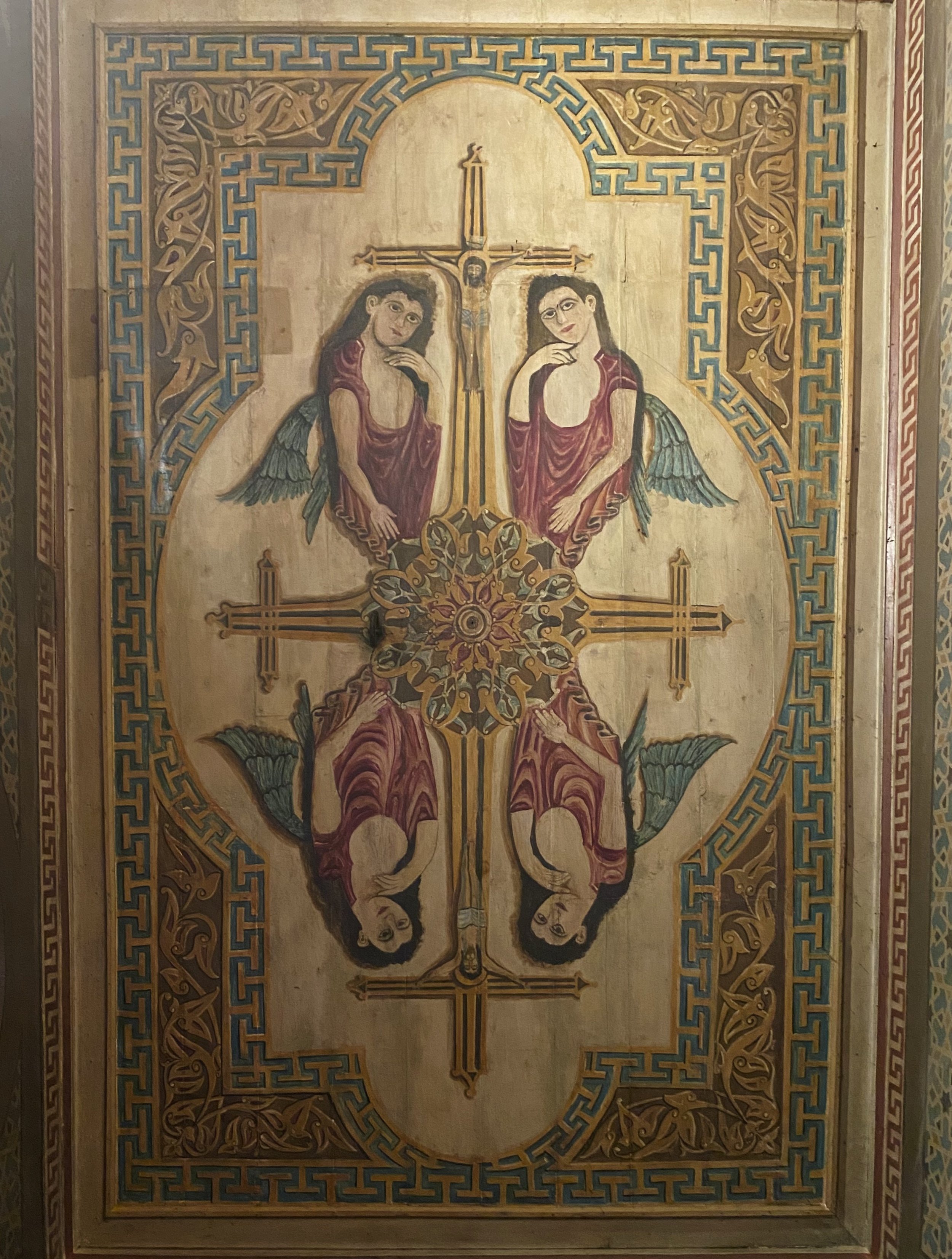
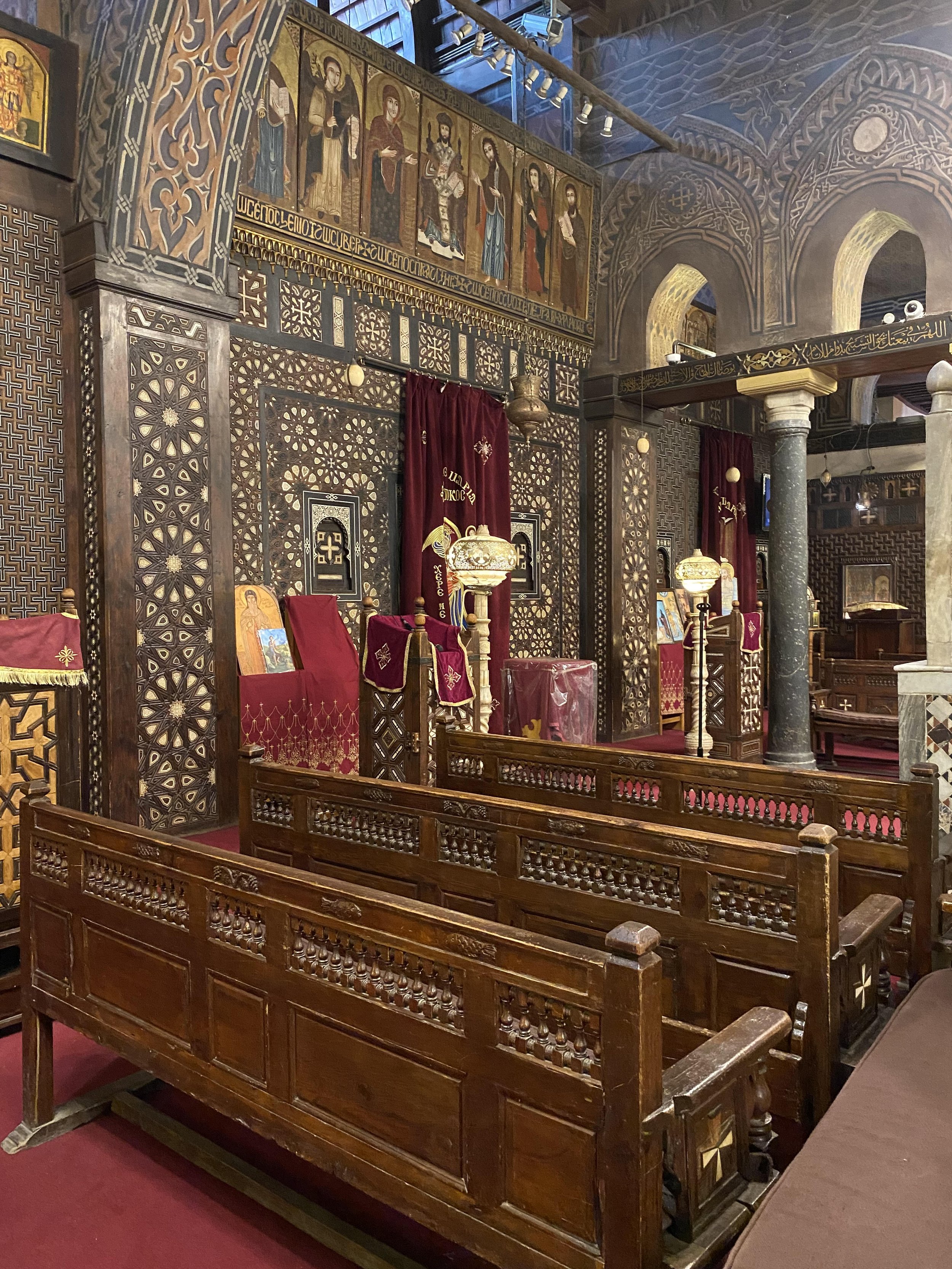
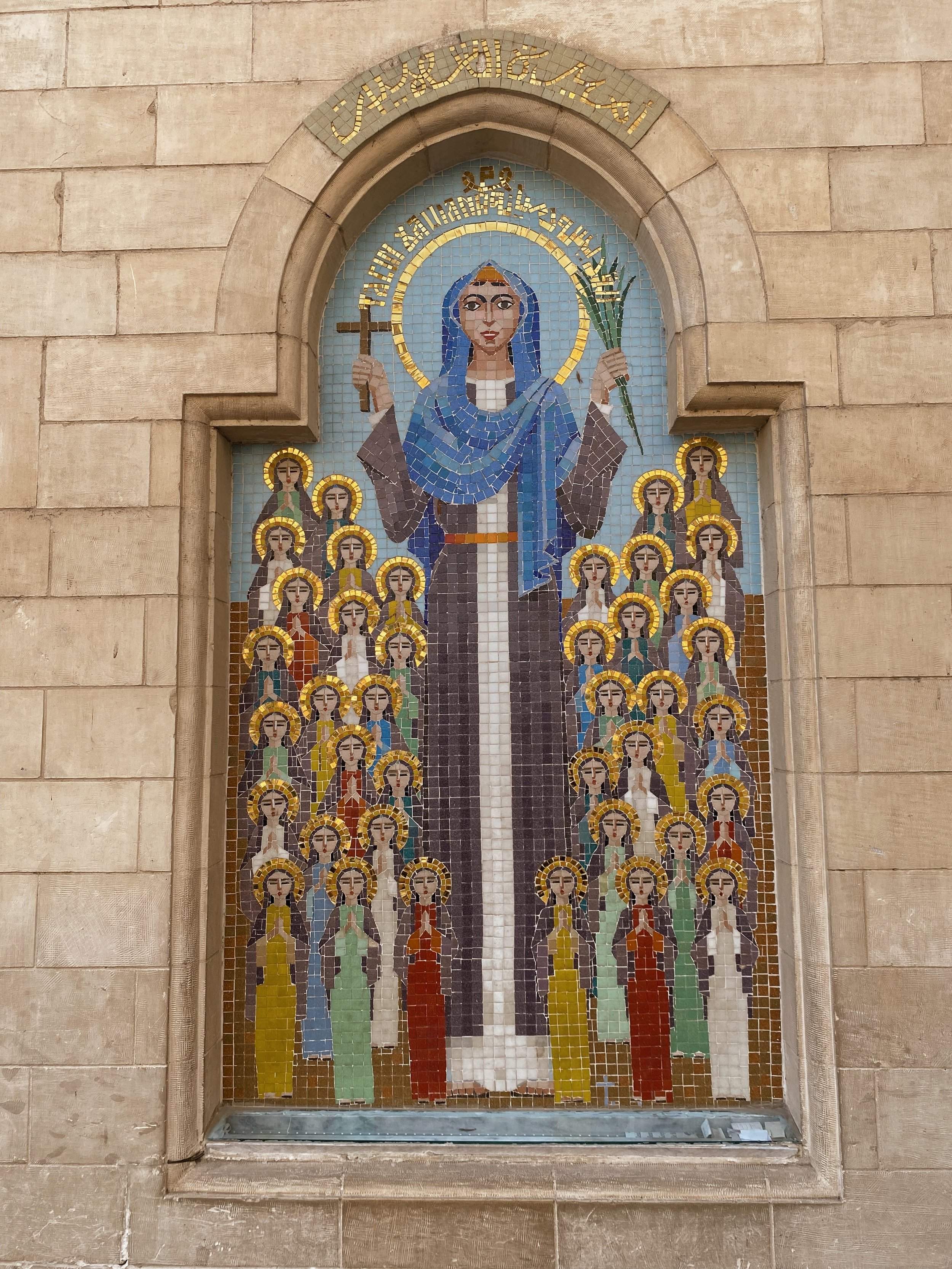
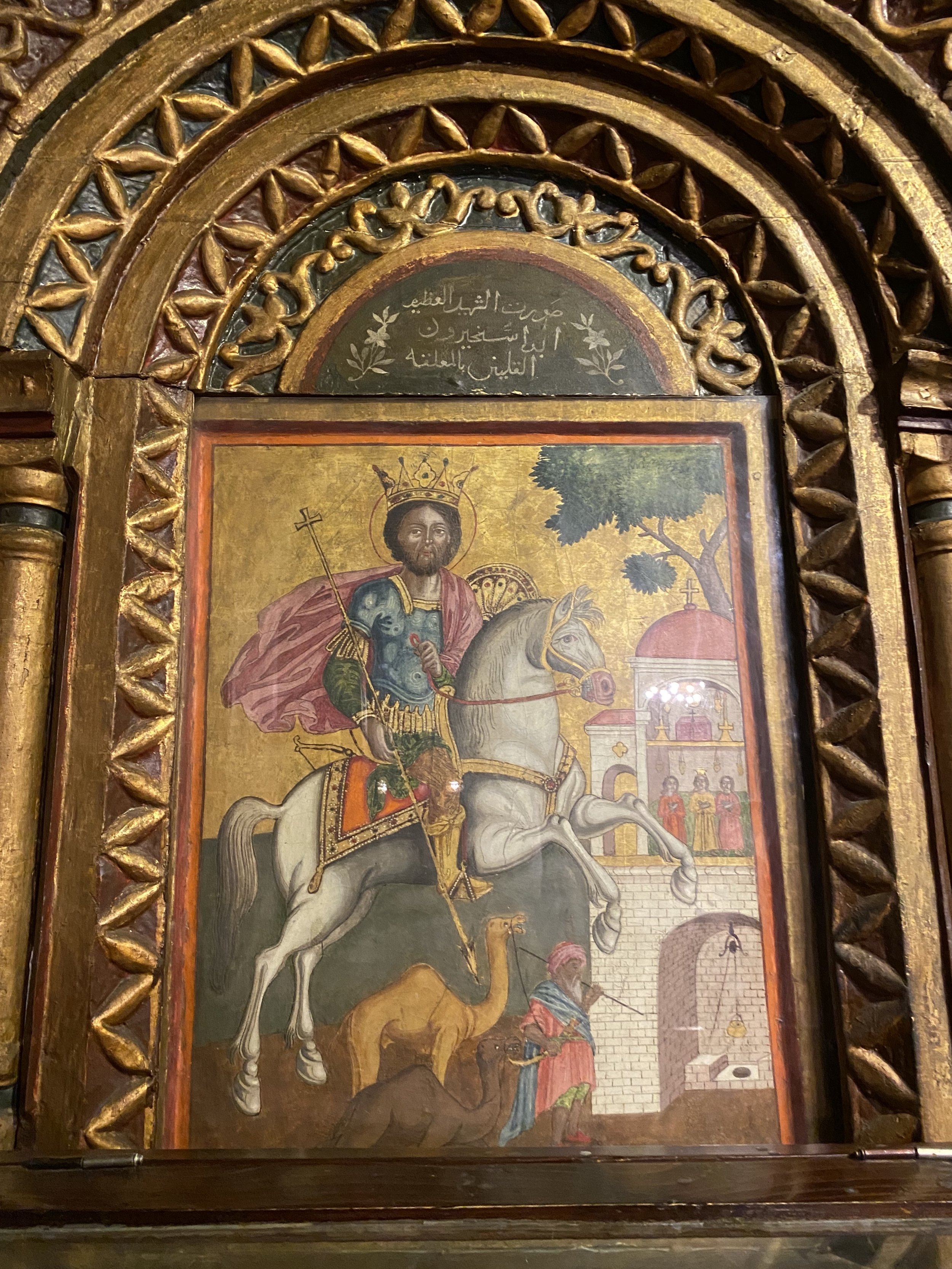
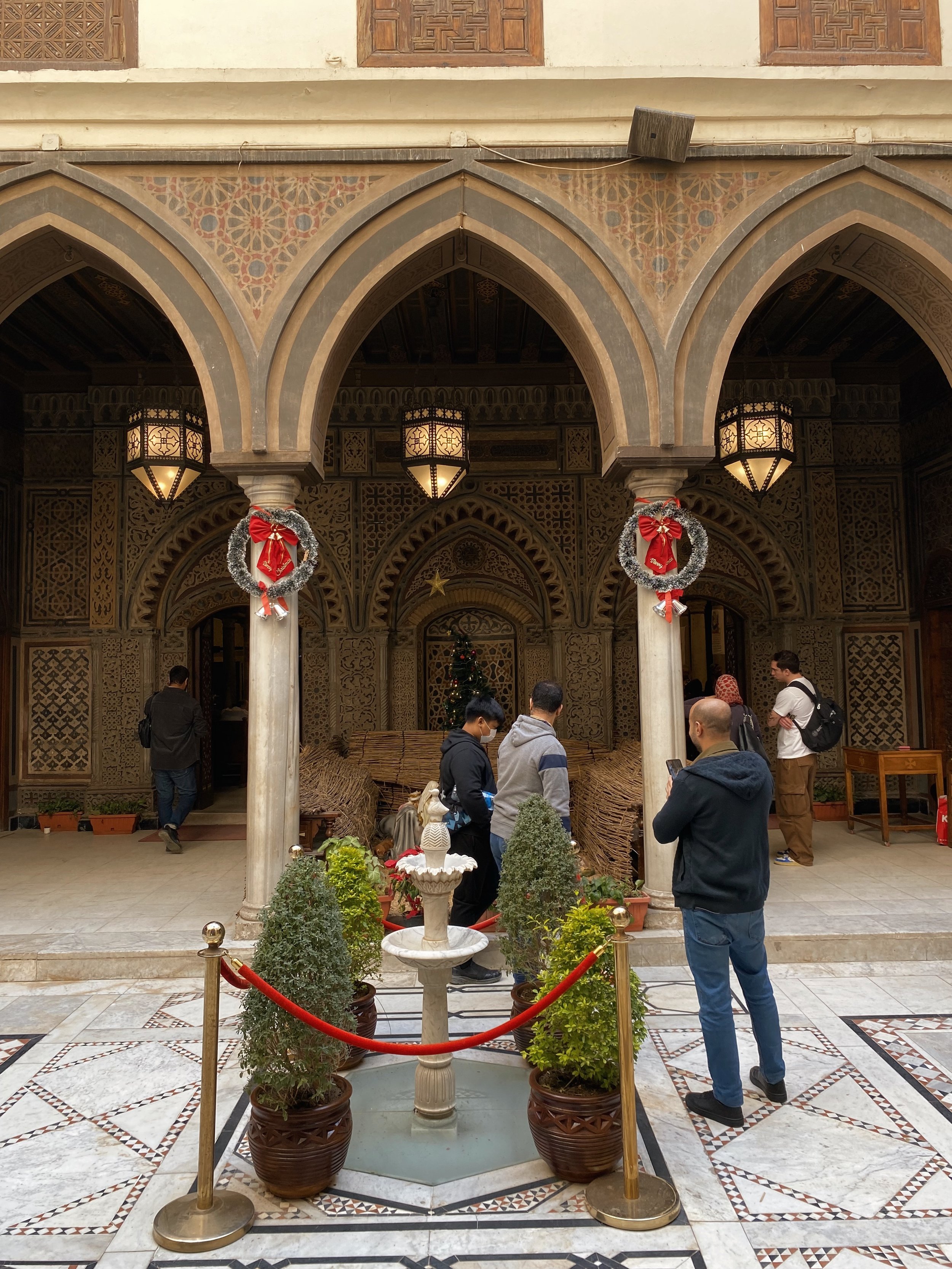
The legend surrounding the Hanging Church is intertwined with the miraculous story of the Mokattam mountain moving. This tale is based on the advice of Saint Simon the Tanner and the faith of Coptic Pope Abraham of Alexandria.
Caliph al-Muizz organized a religious debate where the patriarch Abraham, also known as Pope Abraam.
Abraham won the debate, leading Al-Muizz to challenge him to perform a miracle mentioned in the Gospel of Matthew. The caliph demanded the miracle be done within three days, or else the Copts would face persecution.
Abraham, guided by a vision of Mary, the mother of Jesus, found Simon the Tanner, a one-eyed man. Following Simon's instructions, Abraham and his followers went to the mountain with the caliph and soldiers. By praying and making the sign of the cross, the mountain was miraculously lifted. However, after the miracle, Simon disappeared, leaving the Pope searching for him in vain.
The Mokattam mountain miracle highlights the spiritual aura that surrounds this ancient church and you can find a mosaic capturing this very legend in the Hanging Church today.
You can also visit Saint Simon The Tanner Church in Mokattam which is a 20-minute car ride from The Religious Complex.
2- The Church of St Sergius & Bacchus
Known as Abu Serga, The Church of St. Sergius and Bacchus is believed to have been built in the 4th or 5th century on the site where the Holy Family, according to tradition, rested for three months during their flight into Egypt.
The church is dedicated to Saints Sergius and Bacchus, who were early Christian martyrs. They were officers in the Roman army and became known as Christian soldiers.
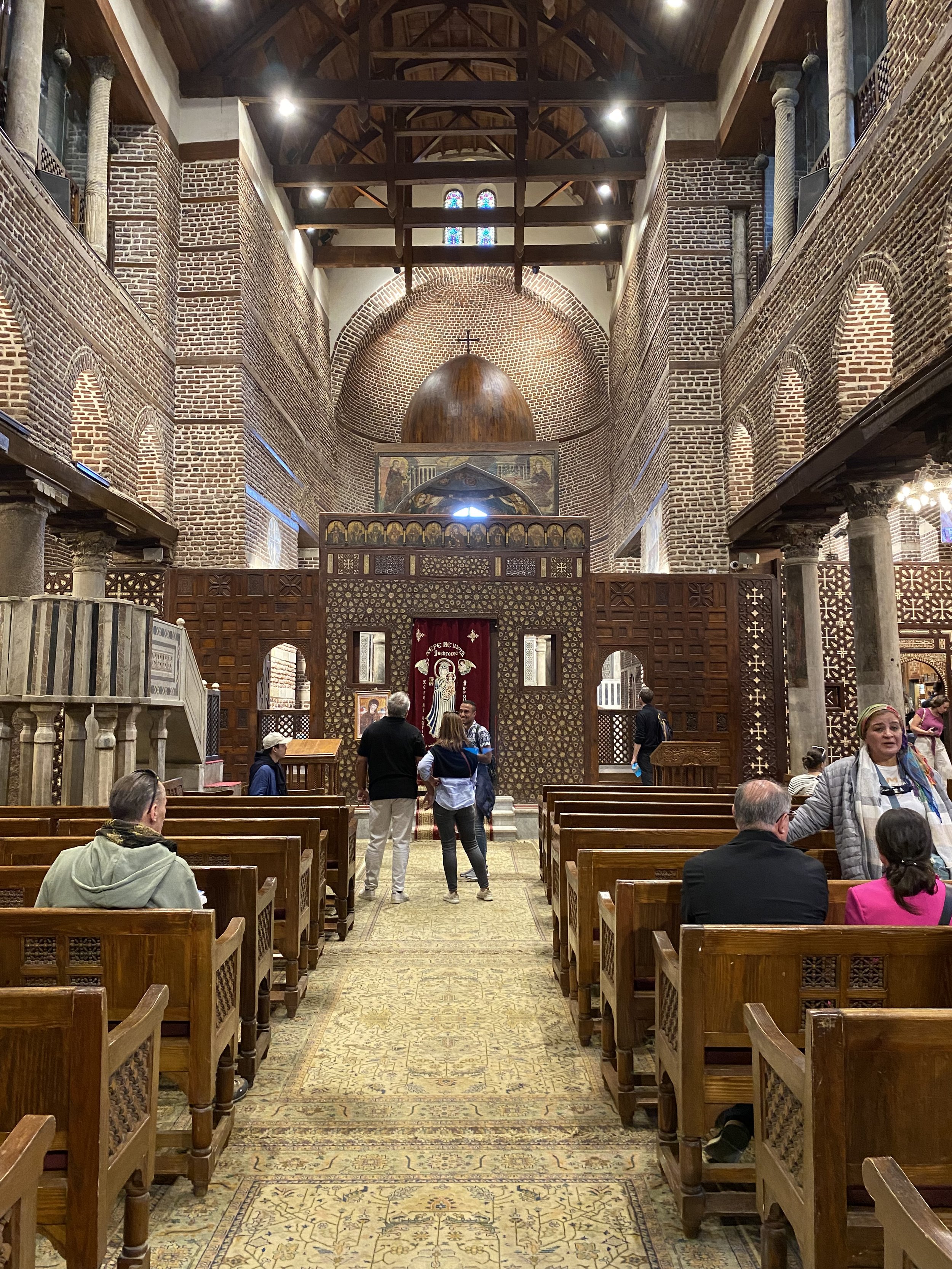
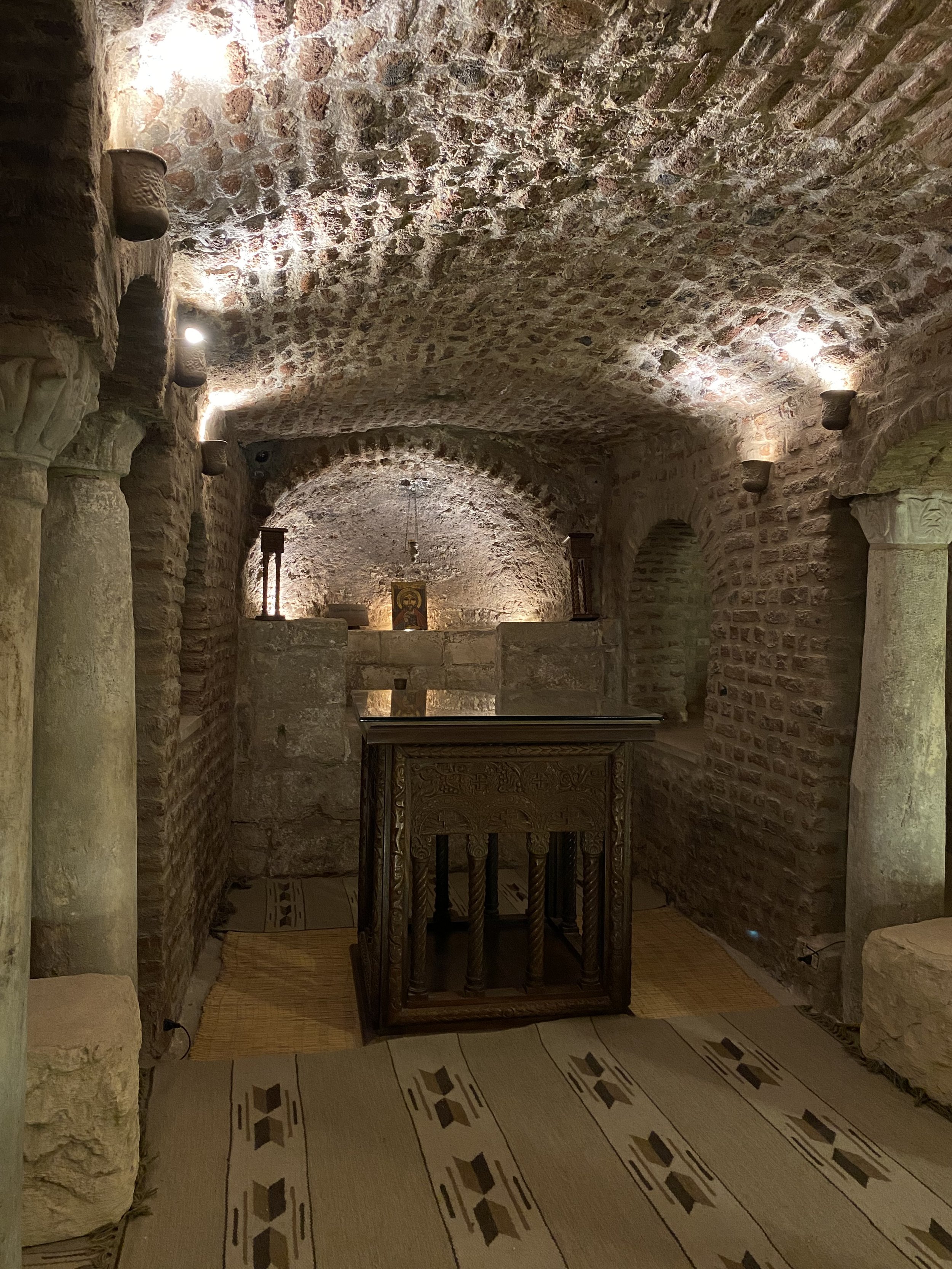
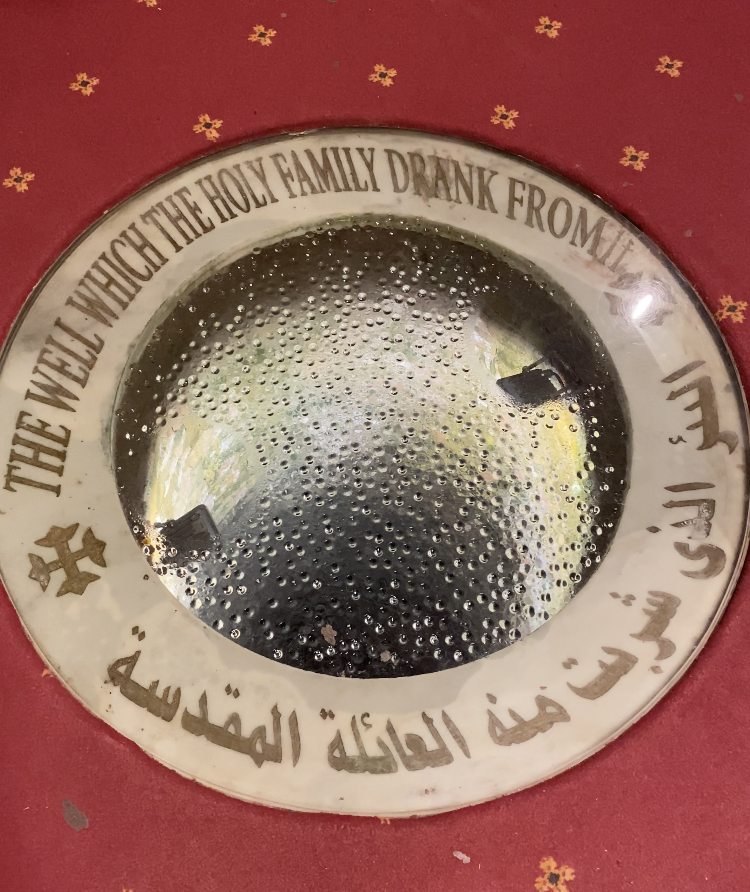
It exhibits a mix of architectural styles, including Coptic, Byzantine, and Arabic influences.
The church is considered a holy site for Coptic Christians due to its association with the Holy Family's journey to Egypt.
Legend has it that a well inside the church courtyard miraculously provided water during times of drought, it’s also said that this is the same well which the Holy family drank from.
Pilgrims and visitors often view this well as a symbol of divine intervention.
3- The Greek Orthodox Monastery & Church of St George
St George (Mar Girgis) is one of the region’s most popular Christian saints. A Palestinian conscript in the Roman army. He is one of the most venerated saints in both the Eastern Orthodox and Western Christian traditions. He is believed to have been born in the late 3rd century. George is often depicted as a Roman soldier and officer in the Roman army. According to tradition, he served under Emperor Diocletian.
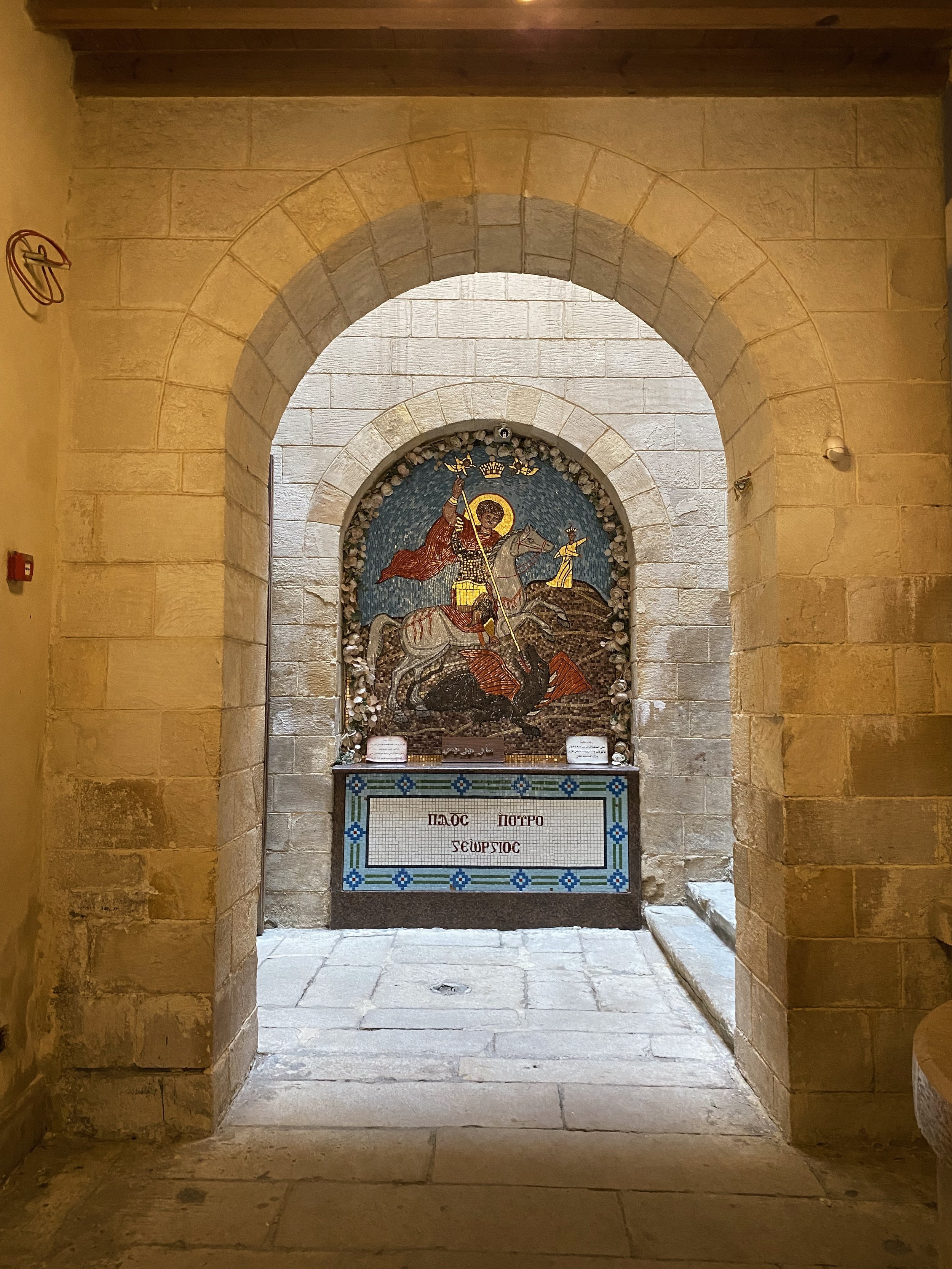
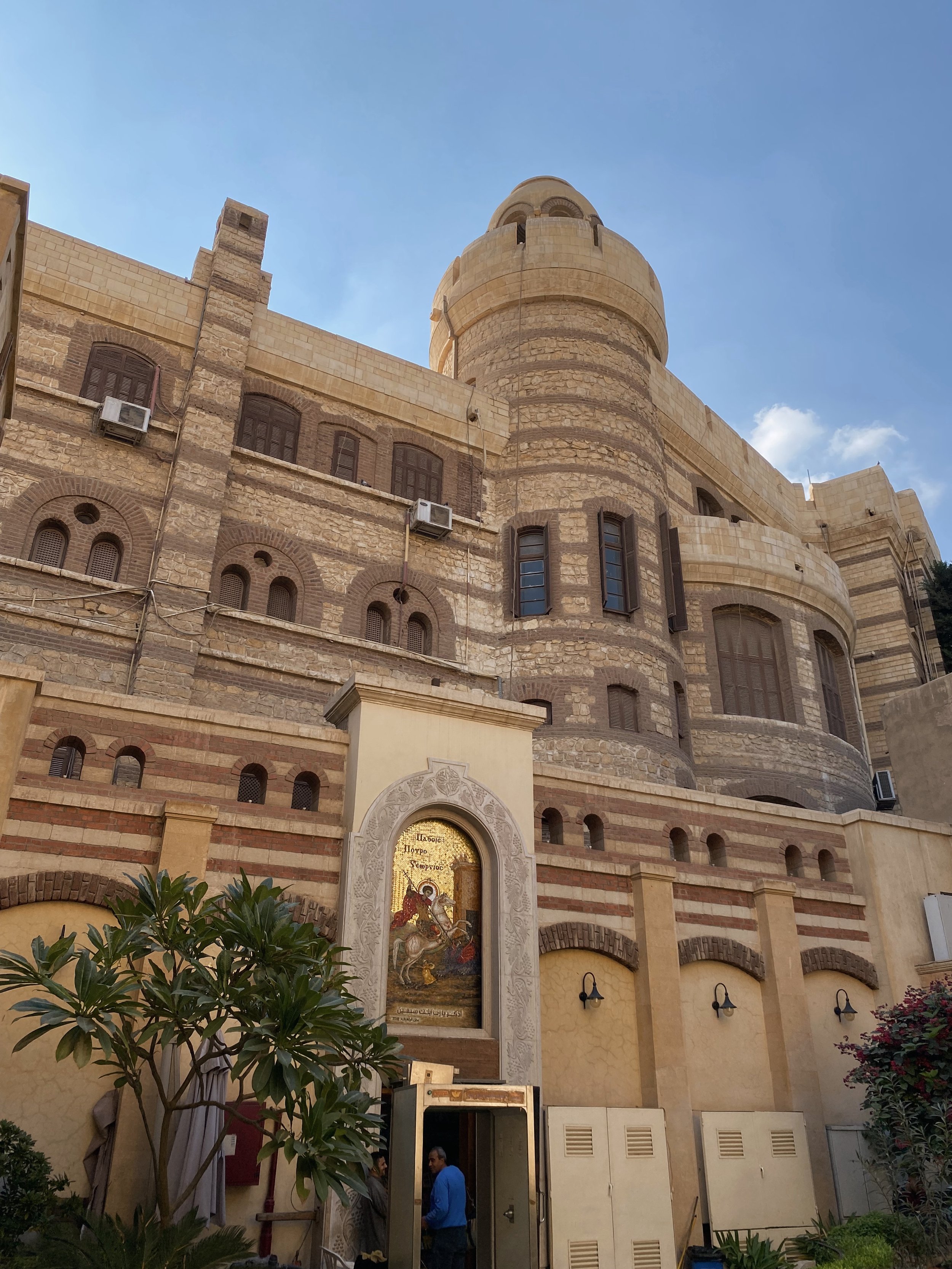


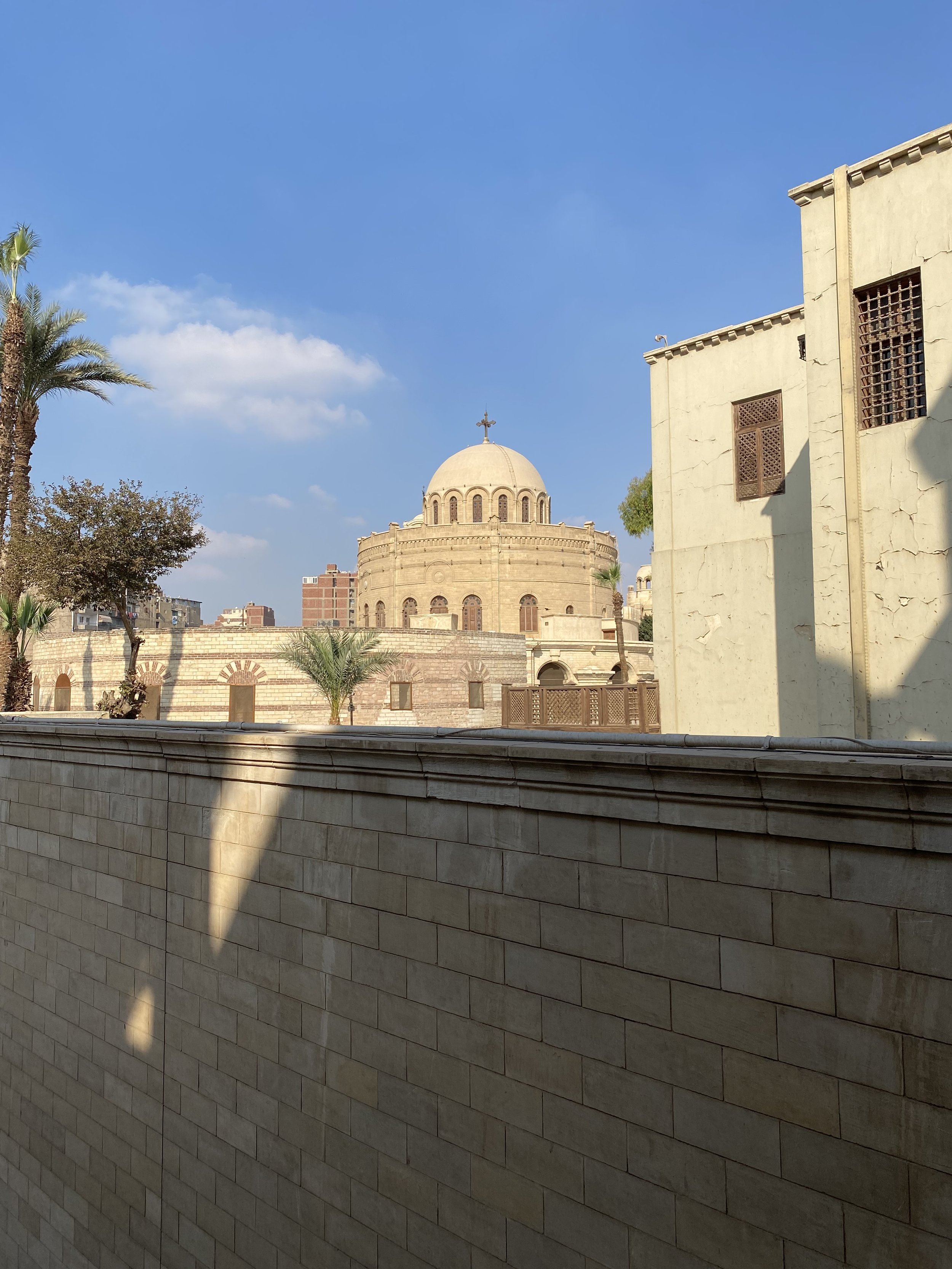
Diocletian's orders led to his imprisonment and torture. Despite facing severe trials, he remained steadfast in his Christian beliefs. The most famous legend associated with St. George is his slaying of a dragon. According to the legend, a dragon terrorized a town, and to appease it, the people offered a human sacrifice. St. George intervened, slayed the dragon, and saved the town. Coptic Cairo has had a church dedicated to St. George since the 10th century or earlier, and the one we see today was built in 1909. According to tradition, the church was built on the same site where St. George was imprisoned in the Roman fortress. Remarkably, the church houses relics and tools believed to have been used in the saint's torture, which have been preserved over the centuries.
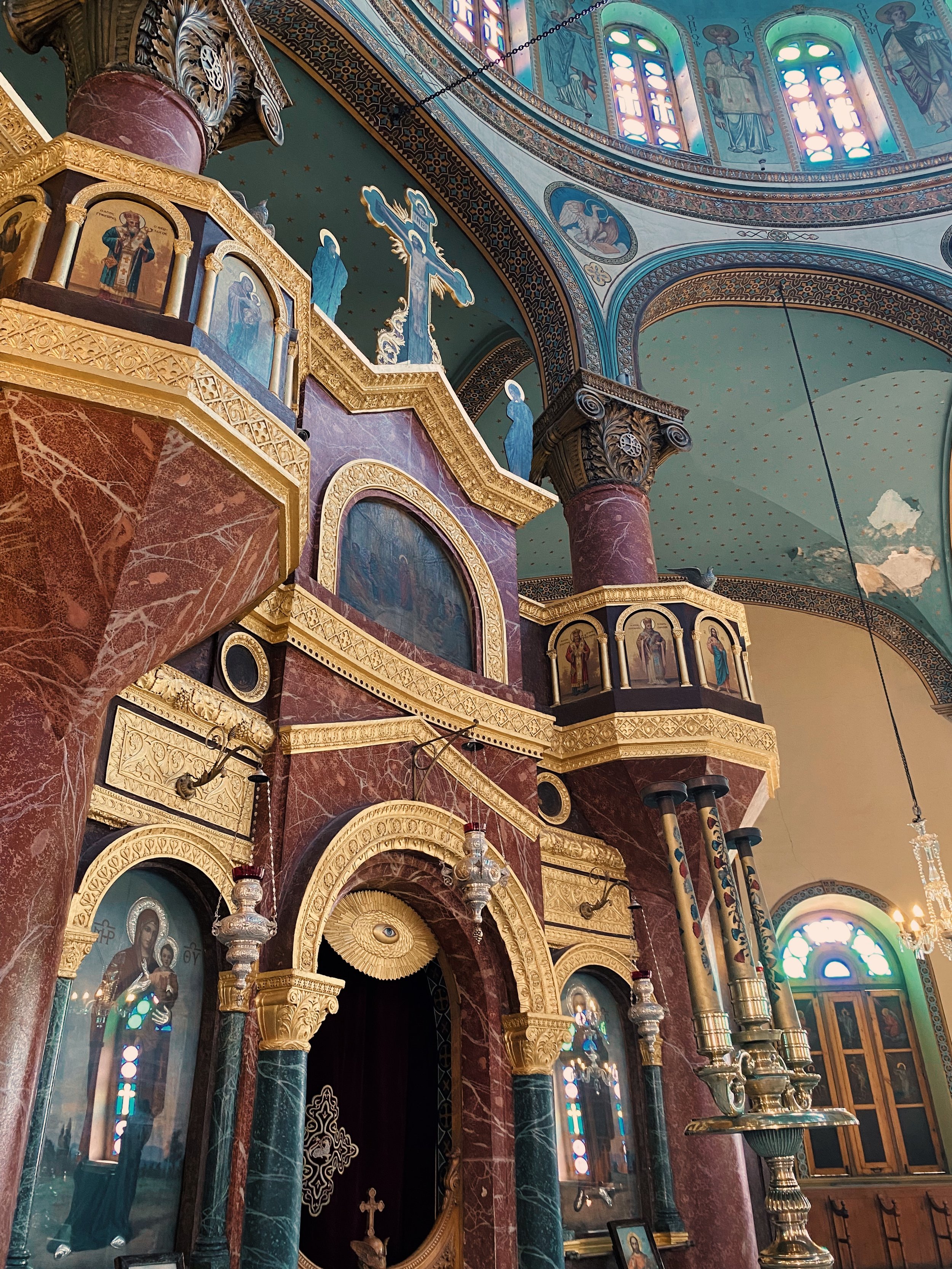
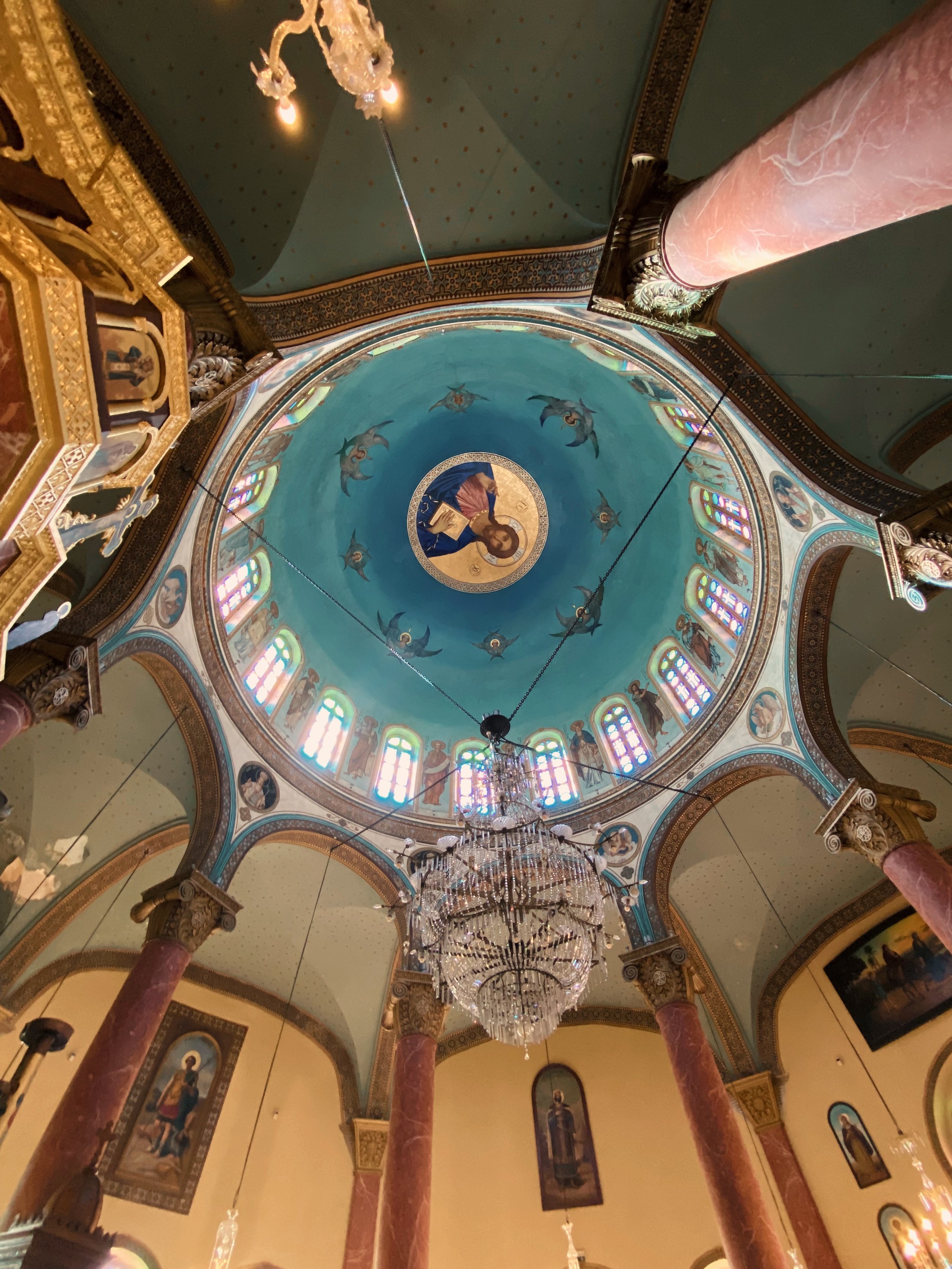
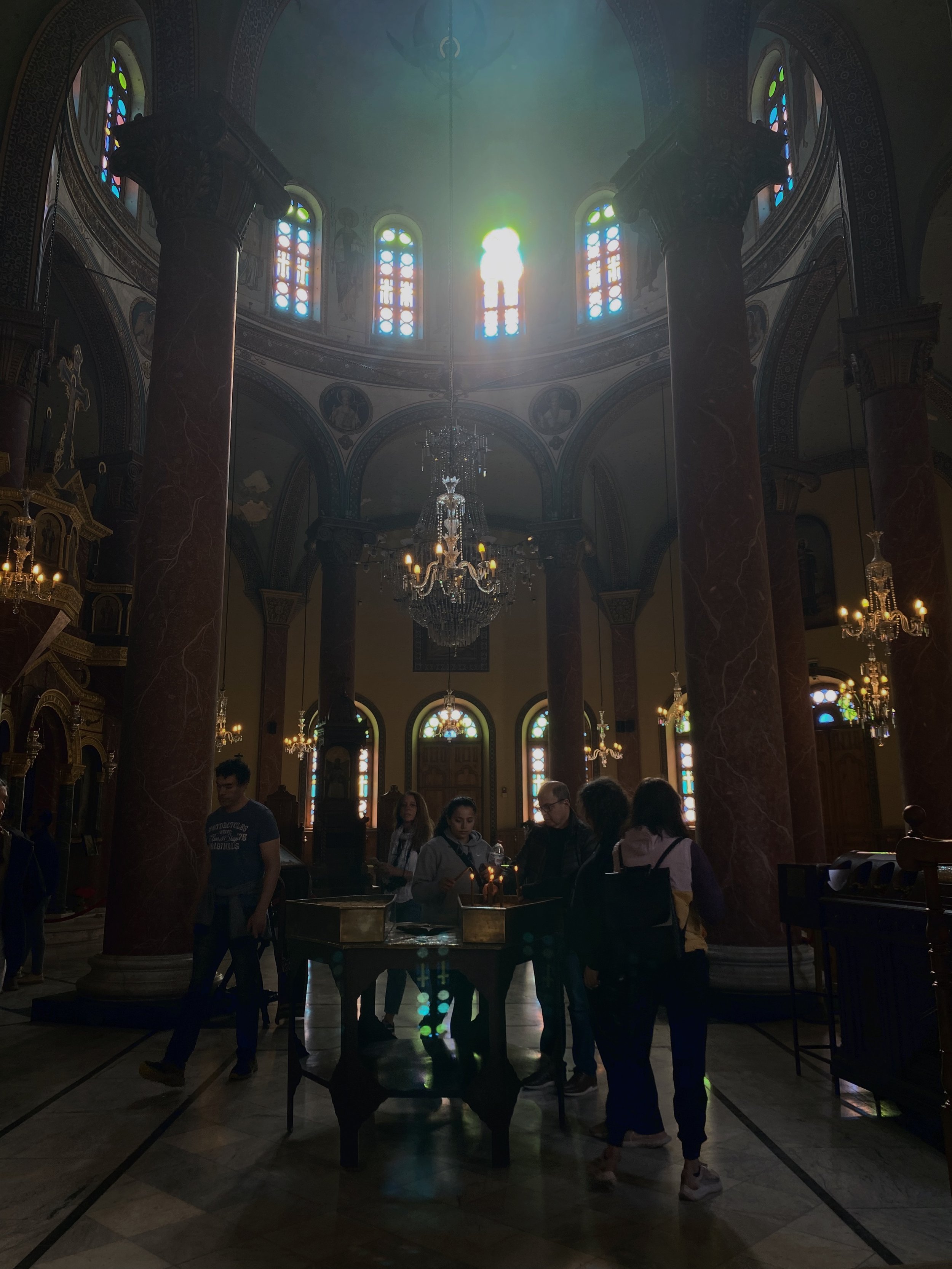
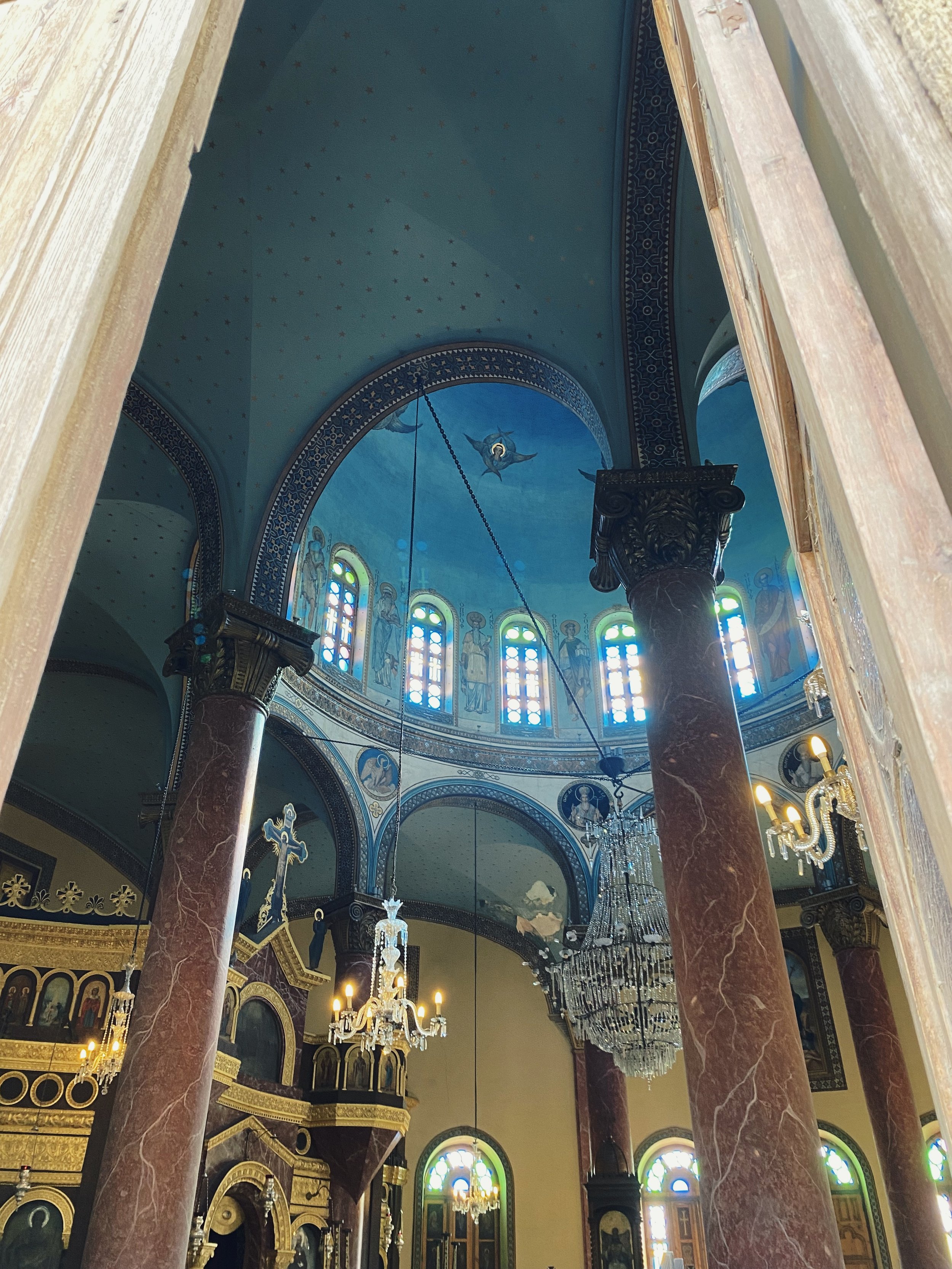
Visitors to the church leave written prayers. When these prayers are answered, devotees express their gratitude by dedicating marble plaques and leaving them with the relics.
4- The Church of Saint Barbara
The Church of St Barbara is dedicated to a martyr who was beaten to death by her father for refusing to revert back from Her Christian Faith. Her supposed relics rest in a small chapel left of the altar, along with a few other saints’ remains. The church houses some rare icons of St Barbara, the Virgin Mary, and Jesus Christ. Saint Barbara’s is considered a twin church to The Church of Abu Serga and next to it is Ben Ezra Synagogue which itself was a church.
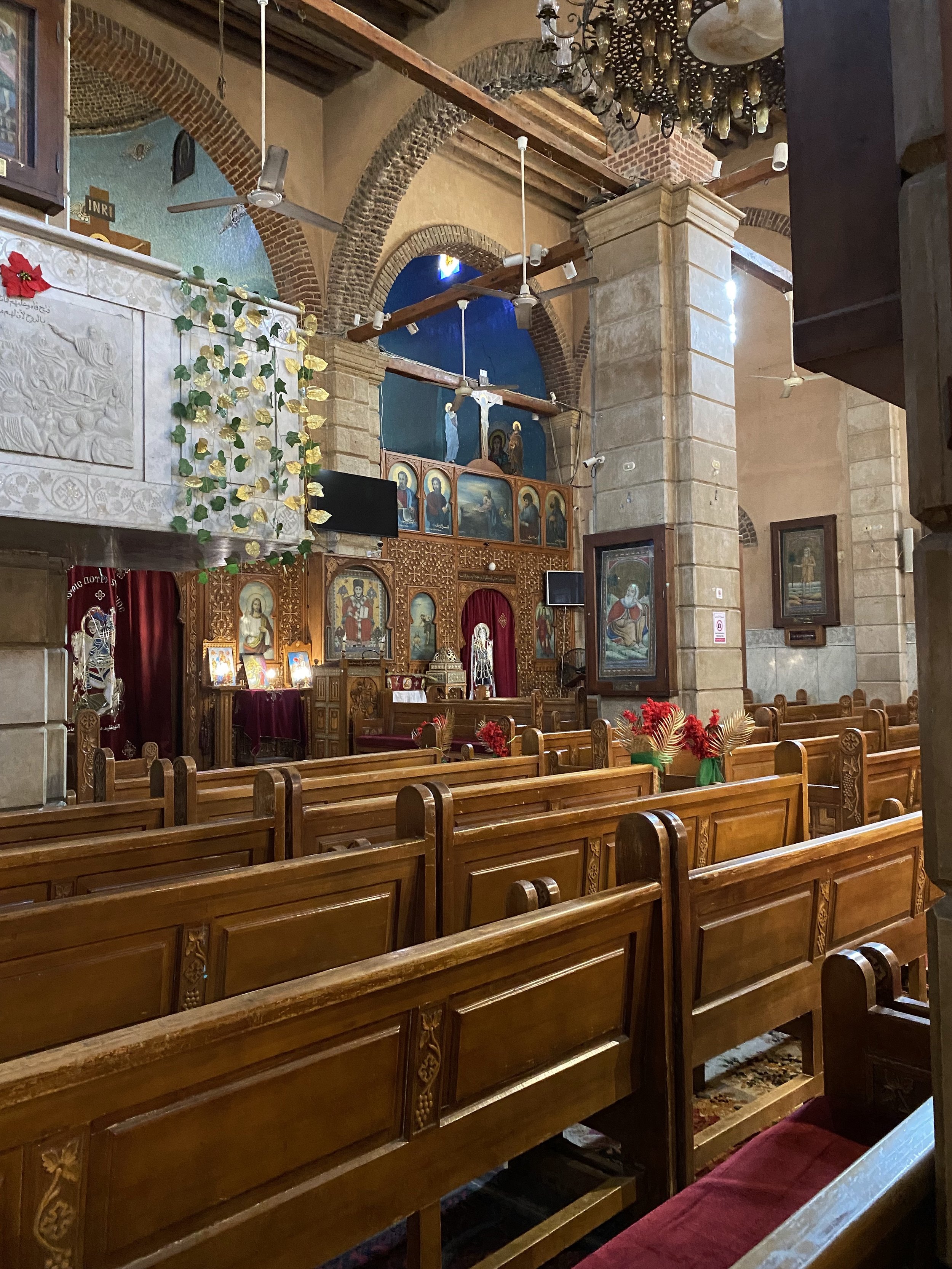
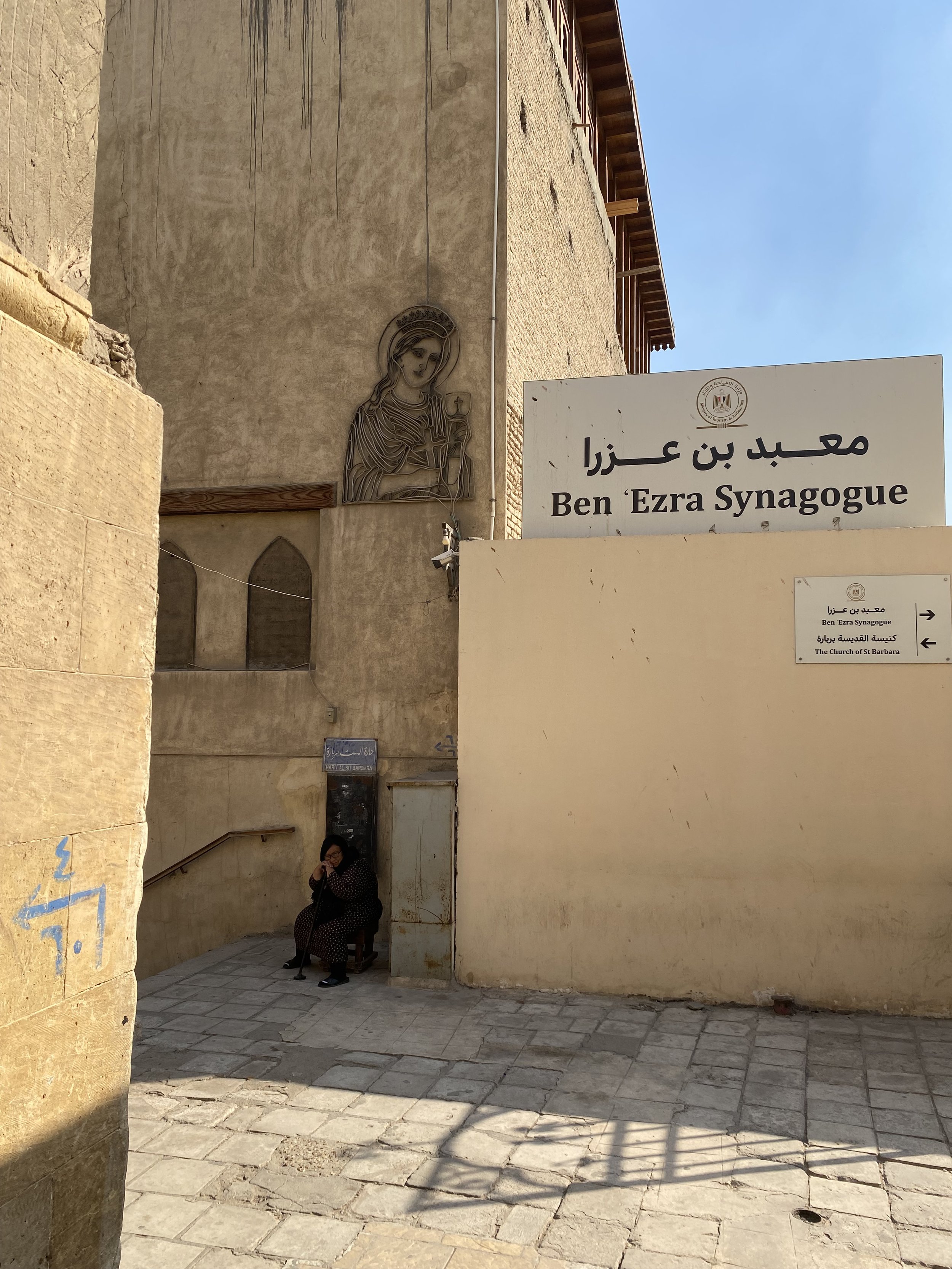
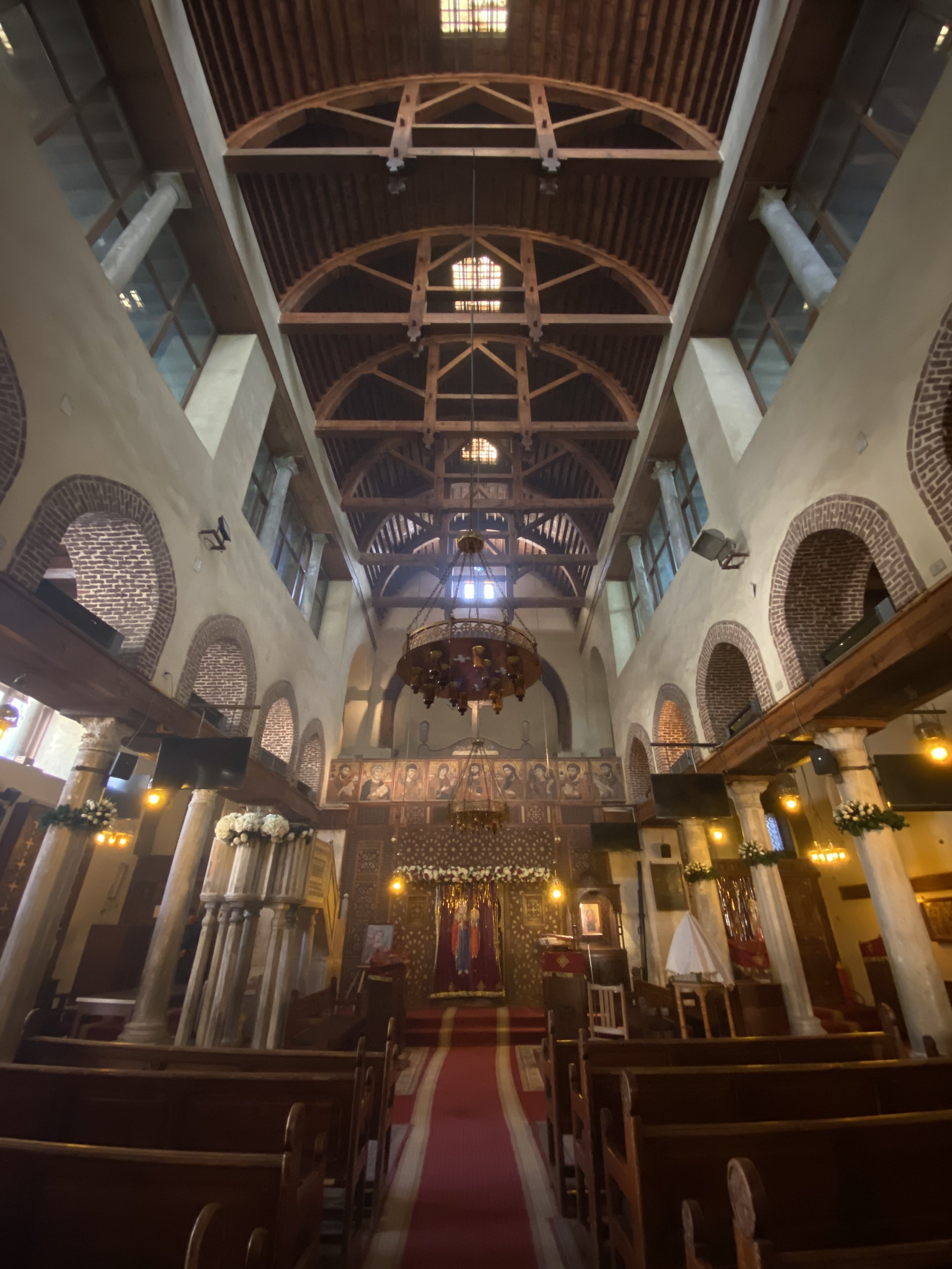
where to go next
Just beyond the complex, we come across the Amr ibn al-As Mosque, a landmark that adds another layer to the cultural area. This mosque, named after the Arab conqueror who founded the city of Fustat, serves as a poignant reminder of the region's centuries-long Islamic influence.
The essence of the Religious Complex is brought to life. It is more than just a collection of religious structures; it is a symbol of the co-existence and harmony that have defined Egypt throughout history. The convergence of different faiths within this historic enclave truly embodies the spirit of diversity and unity, making Coptic Cairo a living testament to the rich and varied religious heritage that continues to thrive in heart of Egypt's capital.
The complex is free to enter and explore, except for the Coptic Museum.
Where can we get a quick bite? Now, we won't be Bellies En-route if we don’t include our favorite restaurants to discover in the area. If you’re getting hungry after a day of exploration, Asmaa recommends Old Cairo Cafe for one of the best falafels in the area. And just outside the complex, we love eating at Haty Abu Ashraf where you can get your Kabab fix.
How do I get there? If you are in Downtown Cairo, you can take the metro directly to Mar Girgis Station!
Can you recommend a guide? Of course! We recommend Walk like an Egyptian who offer custom tours to the Religious Complex. Their expert and friendly guides will give you a brilliant experience.
Om Ali: The Mystical Dessert with a Controversial History
The idiom "we live to eat, not eat to live" is not unfamiliar in Egypt. When visiting any museum in Egypt, it is evident that the Egyptians' passion and admiration for food is a recurring motif.
The idiom "we live to eat, not eat to live" is not unfamiliar in Egypt. When visiting any museum in Egypt, it is evident that the Egyptians' passion and admiration for food is a recurring motif.
You witness murals with lavishly designed dinners and buffets to enjoy with family and friends and to commemorate big events and festivals. It's clear that a basic dessert having controversial origins isn't far-fetched.
Om Ali, which translates as Ali's Mother, has no documented recipe. It was made with ingredients found in the kitchen. Flat Egyptian pastries like Feteer or Rokak were mixed with milk, cream, or condensed milk, and topped with available nuts. It is traditionally served piping hot. Modern versions can use Puff pastry or Phyllo dough instead.
Plain Egyptian Feteer fresh out of the oven
Even though there are no historical references to the actual origin of Om Ali, these are generally held tales found in cultural conversations and culinary anecdotes that agree on the main plot lines but not some of the details. The stories have two things in common: women heroines and Om Ali.
The first stop tells the tale of Shajar Al Durr during the beginning of the Mamluk Dynasty. The Mamluk Dynasty was an Islamic medieval dynasty that ruled from the 13th to the 16th centuries. Originally Asian slave soldiers, the Mamluks rose to power in the Islamic world and established a dynasty with a strong presence in Egypt and parts of the Middle East.
The Mamluk Sultanate region of control.
Source
The Mamluks rose to prominence in Egypt during the Ayyubid period. In 1250, Mamluk commanders, led by Ezz El Din Aybak under Shajar Al Durr, took control and formed the Mamluk Sultanate. This ended the Ayyubid rule.
Shajar Al Durr being serviced by the palace staff
Source
Shajar Al Durr whose name translates to the trees of pearls, was the only woman to rule Egypt alone during the Islamic period, and it was Shajar Al Durr, not Cleopatra, who was the last woman to reign on the Egyptian throne.
After Sultan Salih Ayyub died, the kingdom was under siege by the Crusaders, so Shajar Al Durr covered the Sultan's death, declared him critically ill, and took over as de facto ruler, crushing the Crusaders with an iron fist.
“It was Shajar Al Durr, not Cleopatra, who was the last woman to reign on the Egyptian throne.”
Shajar Al Durr wanted to stay in power but faced resistance and threats of a revolt due to being a woman ruler in an Islamic Dynasty, after eighty days of her reign, she was forced to marry Ezz El Din Aybak, a commander in the Mamluk’s Elite Military under the one condition of divorcing his first wife.
Aybak was the figurehead of the new Mamluk dynasty yet the true authority remained with Shajar Al Durr. He grew tired of the minor role he played and tried to extend his reach as a ruler by taking a new bride, the princess of Mosul. Shajar Al Durr found out his plot and arranged his assassination to remain in power, but there is no solid proof that she ordered his murder.
After Aybak was assassinated, Shajar Al Durr lost her supporters. Al Mansur Ali, Aybak’s first wife's son, then took power with the aid of the Mamluks, who had turned against Shajar Al Durr.
Gustave Dore’s interpretation of Shajar Al Durr ascension to power.
Ali delivered Shajar Al Durr to his mother to decide her fate. Om Ali, Aybak’s widow and first wife, planned her revenge. She had her maids beat Shajar al Durr to death with wooden shoes “Qub Qabs”. Shajar al-Durr was later buried in a tomb, not far from the Mosque of Tulun, which is a testament to Islamic funerary architecture.
WOODEN QUB QABS
Om Ali also ordered a special pudding to celebrate justice served. She came up with the dessert, later named Om Ali by mixing Feteer or Rokak, common daily items available to poor people with the not-so-common ingredients of milk, sugar, and nuts which were expensive. The dessert represents justice and concludes a tale of revenge and retribution and is enjoyed by rich and poor people alike.
Shajar Al Durr’s resting place
Another tale is based on folklore. Om Ali is believed to have once been a commoner celebrated for her charity. When a Sultan came to her town, she wanted to make something special for him. She prepared this dish with the ingredients she had on hand and shared it with neighbours. The Sultan was so taken with it that he requested the recipe and had it produced by the royal cooks, making it famous as a royal treat.
Om Ali in Egyptian traditional clay pot
We are reminded that culinary traditions can spin complex tales of strength, resiliency, and the enduring bond between food and culture as we savor the layers of Om Ali's odd past. This dessert captures the essence of Egypt's culinary and historical legacy. It's creamy and rich, with echoes of the past in every bite.
Would you like to get your hands on our recommendations for where to try Om Ali during your visit to Cairo? Or better yet, join our class to learn how to make Om Ali yourself!
Enjoy 10% off with promo code : COOKOMALI
Splashes of Generosity: Egypt's Incredible Water Sharing Tradition Throughout the Ages
In Egypt, water has always been divine. A desert country with very little rainfall, knows the value of water. Water means life, and as Herodotus once wrote, Egypt is the gift of the Nile.
A desert country with very little rainfall knows the value of water. In Egypt, water has always been divine. Water means life, and as Herodotus once wrote, “Egypt is the gift of the Nile”. There is so much to say about the role that water has played in the creation and continuation of our culture- over 5000 years worth! The practise of providing and sharing water with others is centuries old. As much as things change over time, you’d be surprised at how much some traditions stay the same. One thing that remains is how creative egyptians can be sharing water.
Water Carriers filling their goat skin bags.
Castro, M., CC B-SA 2.5.
Ancient Egypt 2700 B.C - 640 A.D
As with all things Egyptian, we must go back to the ancient period. Times were precarious back then and the balance between Order and Chaos had to be meticulously kept. The order of harmony, peace, and prosperity, (known as Maat and represented by an ostrich feather) versus the wild chaos of violence and injustice, (known as Isfet and represented by a great serpent). Order and Chaos were ancient Egypt’s version of Good and Evil.
It was the divine ruler’s job to make sure society didn’t plunge into chaos. A big part of that was ensuring that there was enough water for everybody- including water for crops ie: the yearly flooding of the Nile. This meant that water was a highly political thing! There are examples from the Old Kingdom (2700 - 2200 B.C) to the New Kingdom (1600 B.C - 1000 B.C) of the state providing a water supply to certain settlements. This was done through the local administration. What did this look like?
“Providing drinking water connects you to the divine- as there is no life without water, and Ancient Egyptians knew this well. Their ability to harness and control water was a major factor to their success as a culture.”
Drinking places were set up in central areas, they consisted of clay water jars that people could go to to collect water from. It was the local administration’s job to make sure there was always water for the town. Water carriers transported the water to the drinking places.
In ancient times, to be a Water Carrier was a career recognized by local authorities. There were rules about where to collect water from to make sure that it was clean. Water would be carried in goat skin bags or clay jars, on their backs, tied to sticks over their shoulders, or on the backs of donkeys to distribution points. This sight of water carriers continued well into the 19th century- we are talking thousands of years!
A water jug being carried in this relief from the tomb of Mereruka in Sakkara.
An Ancient Egyptian water jar at the Metropolitan Museum of Art.
Noblemen have long listed their accomplishments on tomb walls, and there are examples of those who have listed providing drinking places for locals. It was a source of pride and accomplishment, as well as a way to boast their power and social standing. Providing drinking water connects you to the divine- as there is no life without water, and Ancient Egyptians knew this well. Their ability to harness and control water was a major factor to their success as a culture. To this day, sharing water has the same connotations! It’s seen as a life-affirming action.
This charitable act of providing water continues to this day in a pretty similar way!
Islamic Period- Mamluk SulTanATE 1250-1570 A.D
Fast forwarding to the Mamluk period, the tradition of Sabil buildings begins in the 16th century. A Sabil is a public water fountain made possible by an underground water cistern. These kinds of fountains are known as “Sabil” coming from the phrase “ Fi Sabil Illah” translating to doing an act of charity “for the sake of God”. They were built and funded by wealthy individuals from the ruling class. The cistern would fill up during the months the Nile flooded, the water would be treated and distributed for free to passersby.
Sabils are easily recognizable by their large street facing windows covered with heavily decorated metal grilles. These iconic grilles have gaps big enough for cups to be passed through. People on the inside would fill cups with fresh water and pass them through the grilles to the thirsty. Other Sabils would have taps that were accessible from the street. All were welcome to stop for a cool and refreshing drink. Today, these historic Sabils are appreciated and studied for their iconic architectural design and decorative motifs.
Sabil of Abdel Rahman Katkhuda in 1936.
Sabil of Abdel Rahman Katkhuda in 2015.
Sailko, CC BY 3.0.
In Islam, there are different kinds of good deeds. Providing water as a charitable act is considered “Sadaka Garya,” a good deed that keeps on giving. For every person who drinks from the water you have provided, it is considered a good deed. And in a hot country like Egypt, it’s an ideal charitable act. When it comes to sabils, water is often provided as a charitable act on behalf of a deceased person. Sadaka Garya is the only way a dead person can amass good deeds- so setting up a Sabil in honor of a passed loved one is a great act of kindness. This is why almost all Sabils are named after people, even to this day!
Sabils were for drinking only, not for collecting water for domestic uses. For that, Cairenes would either visit the closest canal or lake to fill up on water, visit a water seller or if wealthy enough, have water delivered by water carriers. During this period water was hard to come by, and often, people would outsource all of their water needs. Bathing happened at public bath houses and laundry was sent to the market to be cleaned.
The flooding of the Nile near the Pyramids, circa 1890s.
Early modern period-Ottoman Egypt 1517 - 1867
During the Ottoman period, (the tradition of Sabil building continued but with their own decorative style. Today, about 70 Sabils are still standing in Cairo, tucked away in historic neighborhoods and very worth the visit. Unfortunately, they don’t give out water anymore, but empty cisterns mean you can go underground down and see how the water was stored!
In 1865, Egyptian sovereign Khedive Ismail allowed French hydraulic engineer Jean Antoine Cordier to establish the Cairo Water Company. In his attempt to modernize Egypt in preparation for the opening of the Suez Canal, a few short years later (in 1869), Khedive Ismail wanted to bring water pipes to the homes of Cairo.
Egyptian Women collecting water from the Nile in clay water jugs.
Until then, Cairo was full of canals and lakes. Where are these canals and lakes now, you might ask? They were filled in and are now major roads in the city. By 1887, the Cairo Water Company had provided water to 3600 of the 5500 homes in Cairo. As more and more homes were given water pipes, the demand for water carriers waned.
Modern Period
Even though the vast majority of the city has access to water pipes, the tradition of sharing water is very strong- particularly in increasingly hotter summer months (thanks global warming!). Today, the Sabil has taken on a different appearance. Four different versions to be precise: the Olla, the Zeer, the Coleman and the Coldaire. Varying in size and material, these water dispensers line the streets of Egypt for any and all to drink from.
A set of Zeers on their stands in an historic cemetary in ElMinya. Photo by Dina Elgohary
The Olla and Zeer are unglazed clay water jugs that keep their contents cool through the evaporation of water from their surfaces. Both need to be cleaned and filled daily. They are traditional and much loved.
For some, though, the Olla and Zeer are considered to be unhygienic because of their porous material and open tops. This is where the Coleman and Coldaire come in! Both are now known by their original brand names. The Coleman is a plastic insulated tub with a tap and the Coldaire is a refrigerated water dispenser, the most expensive of the four.
Two Coldaires, one with a green and white sign indicating that it has been set up in memory of a loved one.
You’ll see these modern day sabils in front of apartment buildings, small shops, mosques etc. They are set up by individuals who want to provide for their community members. Cleaning, filling and maintaining these sabils is a daily task and big commitment. It's common for a Sabil to be set up in memory of a loved one, where even in death they can give back to their community. Some Sabils will have writing on them, sometimes it’s a Quranic verse, and sometimes it’s the name of a deceased loved one.
Often you will find plants near by these Sabils, or a small container on the floor to catch spilled water. This is so that the water doesn’t go to waste! Extra water that isn’ t drunk can be poured into a plant pot, put into the small container for the street cats and dogs, or even left in the cup for the next person to drink.
There is just so much more to be said about Egyptian water culture, from agriculture to politics. But consider this a glimpse into one small aspect of Egyptian life and culture. Next time you’re walking around town and see one of these Sabils, remember how far back this tradition goes!
REFERENCES AND EXTRA READINGS FOR NERDY FOLK:
Ahmed, A. T., Gohary, F. E., Tzanakakis, V. A., & Angelakis, A. N. (2020). Egyptian and Greek Water Cultures and Hydro-Technologies in Ancient Times. Sustainability, 12(22), 9760. https://doi.org/10.3390/su12229760
Attia, F. A. (1999). Water and Development in Greater Cairo (Egypt). DOAJ (DOAJ: Directory of Open Access Journals). https://doaj.org/article/c8b05b78338a42c9a2545197293e946f
Dobrowolsk, A., & Dobrowolski, J. (2016, November). The Sultan’s Fountain. ARAMCO World. Retrieved June 6, 2023, from https://www.aramcoworld.com/Articles/November-2016/The-Sultan-s-Fountain
Driaux, D. (2016). Water supply of ancient Egyptian settlements: the role of the state. Overview of a relatively equitable scheme from the Old to New Kingdom (ca. 2543–1077 BC). Water History, 8(1), 43–58. https://doi.org/10.1007/s12685-015-0150-x
Farmer, T., Throckmorton, M., & Rahaman, F. (2020, March 2). The Sabils of Cairo: Small Scale Urban Adaptations to Water Stress. The Journal of Sustainability Education. Retrieved June 6, 2023, from http://www.susted.com/wordpress/content/the-sabils-of-cairo-small-scale-urban-adaptations-to-water-stress_2020_03/
Hawass, Z., & Richards, J. C. (2007). The archaeology and art of ancient Egypt : essays in honor of David B. O’Connor. http://ci.nii.ac.jp/ncid/BA87545274
Nikiel, C. A., & Eltahir, E. a. B. (2021). Past and future trends of Egypt’s water consumption and its sources. Nature Communications, 12(1). https://doi.org/10.1038/s41467-021-24747-9
Pasquier, É. (2022, June 15). Politics of Nature: The Cairo Water Company in 19th-Century Egypt. Environmental History Now. Retrieved June 6, 2023, from https://envhistnow.com/2022/06/15/politics-of-nature-the-cairo-water-company-in-19th-century-egypt/#_ftn3
Shehata, F. (2019). The Water-Carrier in Graeco-Roman Egypt. The Journal of Association of Arab Universities for Toursim and Hospitality, 17(1), 1–15.
Soliman, M. M. (2017). VIRTUAL REALITY AND THE ISLAMIC WATER SYSTEM IN CAIRO: CHALLENGES AND METHODS. International Journal of Architectural Research, 11(3), 78. https://doi.org/10.26687/archnet-ijar.v11i3.1386
6 Unique Places to See if You've Already Visited Cairo's Hotspots
Lucky for you, we're here to spill the beans on 6 (actually 7) seriously underrated stops you can't miss on your next Cairo adventure. If you're all about exploring off the beaten track, then keep reading.
So you have already been to cairo- Been there, done that. What now? We’ve Got you covered.
Egypt has been a go-to destination for ages, and you know what? It's got all the goods to back up the hype! Cairo, in particular, is a treasure trove of incredible sights that'll keep you coming back for more. But here's the thing: not everyone knows about the hidden gems tucked away in this vibrant city. Lucky for you, we're here to spill the beans on 6 (actually 7) seriously underrated stops you can't miss on your next Cairo adventure. If you're all about exploring off the beaten track, keep reading.
If you liked: The Pyramids of Giza
The Pyramids of Giza are at the top of every tourist’s list. If you’ve been to Cairo you’ve been to see the pyramids. If you enjoyed this spectacular sight, check out the next suggestion.
Then you should visit: The Step Pyramid of Djoser
This gem takes you back to where it all began. Not only is it the oldest pyramid in Egypt, but it holds the title for the oldest pyramid in the whole wide world! Can you believe it? The Step Pyramid predates the Giza Pyramids by a whopping 200 years and even outshines the pyramids of Caral Supe in Peru by at least a century. Talk about ancient wonders! Plus, here's a cool tidbit: it was the very first attempt in Egyptian history to construct a massive structure using limestone instead of plain ol' mud bricks. Get ready to dive deep into history and marvel at the ingenuity of the ancient Egyptians. This is a stop you won't want to miss!
If you liked: Khan elKhalili Market
This historic market has been a bustling hub since the 14th century, and it's a go-to spot for every tourist in Cairo. It’s renowned for its dazzling array of jewelry, traditional crafts, aromatic spices, captivating perfumes, and large collection of unique souvenirs.
Then you should visit: Kheyameya street Market
Just a quick 10-minute jaunt from the bustling Khan el-Khalili Market lies a secret spot you won't want to miss: Kheyameya Street. "Kheyameya" means "tent maker," and this street is where the talented tentmakers of Cairo used to showcase their magnificent tent covers and fabrics, designed to dazzle during ceremonial events. Kheyameya also refers to a specific type of applique textile art that's unique to Cairo. Fast forward to today, and you'll find yourself strolling through a vibrant street market filled to the brim with beautifully decorated hand-crafted pillows, bags, and wall hangings, all done in the distinctive style and technique of Khayameya. It's an absolute paradise for souvenir hunting, and the best part is that you'll be supporting local artisans with every purchase.
If you liked: The Egyptian Museum
It’s only the largest collection of Ancient Egyptian artifacts in the world. Not. To. Be. Missed.
Then you should visit: The Museum of islamic Art
Brace yourself for an incredible assortment of Islamic art that'll blow your mind. With a jaw-dropping collection of over 100,000 objects, this museum proudly boasts the title of being the world's largest collection of Islamic art. With artifacts from the start of the Islamic Period in the 7th century all the way to the end of the 19th century, this place houses astounding variety from across Islamic world. Despite how great it is, it quite underrated, often overlooked by many tourists. But trust us when we say that a visit to this remarkable museum will leave you speechless. From exquisite calligraphy and breathtaking ceramics to mesmerizing textiles and awe-inspiring metalwork, the Museum of Islamic Art is a true haven for art enthusiasts and history buffs alike.
If you liked:al-Muizz street in Historic Cairo
This 10th-century road is a gold mine of architectural gems, offering a glimpse into the city's rich history.
Then you should visit: The Religious Complex in Historic Cairo
The Hanging Church
Just a short drive from al-Muizz street, you'll find something truly special: the Religious Complex, also known as "mogama’ el-adyan." This place is like no other—it brings together Judaism, Christianity, and Islam in a way that'll blow your mind. We're talking about the Fortress of Babylon, the Hanging Church, the Church of St. Barbara, the Coptic Museum, the oldest mosque in Egypt (Amr Ibn al-As Mosque), and even the famous Ben Ezra Synagogue where they found the Cairo Geniza papers. It's a spot overflowing with history, culture, and a unique blend of traditions. You won't find anything quite like it anywhere else.
If you liked: Bayt elSuhaymi (House of Suhaymi)
Located in Darb el-Asfar, just off of al-Muizz street, is a famous medieval home that was built in 1648. It serves as a common stop for tourists visiting al-Muizz street and offers a glimpse into the architectural and historical aspects of the medieval and Ottoman era.
Then you should visit: Gayer Anderson Museum or Ramses Wissa Wassef Art Center
Ramses Wissa Wassef Art Center
If you’re into architecture, you can't miss the Gayer Anderson Museum and the Wissa Wassef Art Center. The Gayer Anderson Museum is an absolute stunner, housed in a medieval home with an interesting past, that got completely restored in the 1930s thanks to British Major Gayer Anderson. Prepare to be blown away by its unique interior decoration and timeless beauty.
Let's talk about the Wissa Wassef Art Center in Giza. This place is something else! It's constructed entirely from natural and local materials like mud bricks and limestone mortar in an Upper Egyptian style. The genius behind it all is architect Ramses Wissa Wassef, who wanted to create a space where local young talents could shine. And shine they do! The center is world-famous for its mind-blowing tapestry art. So, while you're there, be sure to take in the incredible artwork and maybe even take a piece of their talent home with you. These spots will make your architectural-loving heart skip a beat!
If you liked: Eating Koshary and Falafel
Koshary in action
You've had the pleasure of devouring mouthwatering Koshary and scrumptious Falafel, but felt like something was missing…
Then you should visit: The Bellies En Route website & book a FOOD tour with us!
Excited to try fried brain for the first time
Cheers!
Prepare yourself for an immersive experience as you embark on a journey through the streets of Cairo with your newest friend (that's us!). Not only will you get to indulge in delectable Egyptian cuisine, but you'll also gain a deeper understanding of the rich cultural context behind it. From traditional recipes passed down through generations to the fascinating stories behind each dish, we've got you covered. Our tours go beyond just food. As we meander through the vibrant city, we'll discuss captivating topics like architecture, cinema, politics, and history, all while passing by significant landmarks that make Cairo truly special. So, if you're craving a well-rounded culinary and cultural adventure, head over to the Bellies En-route website and book a tour.
Off The Beaten Track: Cairo For Art Lovers
So you’ve visited all the historical sites and done all the touristy things? You’re looking for something a little different- something off the beaten track? Oh, and you’re an art lover? Say no more! Here are 10 interesting and underrated places to visit to get to know Cairo’s art scene.
So you’ve visited all the historical sites and done all the touristy things? You’re looking for something a little different- something off the beaten track? Oh, and you’re an art lover? Say no more! Here are 10 interesting and underrated places to visit to get to know Cairo’s art scene.
Zamalek’s Art Galleries
Safarkhan Gallery
Spend a relaxing afternoon walking around Zamalek appreciating Egyptian modern and contemporary art. This charming neighborhood houses many art galleries, some of which are quite old in and of themselves. While many of the galleries are located around Brazil st, don’t be afraid to walk around - you’ll definitely stumble across quite a few more! Galleries to look out for: Safarkhan Gallery, Dai Zamalek, Picasso Art Gallery, Zamalek Art Gallery, Art Corner, Al Masar Gallery.
Mahmoud Mokhtar is by far Egypt’s most famous sculptor as well as the leading figure of Egyptian nationalist modern art. He is known for impeccably blending Pharaonic and traditional agricultural themes. Mokhtar was a proud nationalist and stood against the British during the 1919 revolution- he was political and so was his work! “Egypt’s Renaissance”- his most famous statue sits just in front of Cairo University, to see the rest of his work, you have to visit his museum!
Mohamed Mahmoud Khalil Museum- Dokki, Cairo
Mohamed Mahmoud Khalil Museum, Abdallahelhaty, CC BY-SA 4.0
This museum was built in 1962 and was dedicated to two time Prime Minister of Egypt Mohamed Mahmoud Khalil Basha and his wife Emiline Lock. It is home to a collection of impressionist paintings acquired before 1928; displaying works from masters such as Gaugin, Monet, Renoir, Rodent, and Van Gogh.
Museum of Islamic Art- Downtown Cairo
Exhibition Hall in the Museum of Islamic Art, Prof. Mortel, CC BY 2.0
This stunning museum in downtown Cairo houses one of the largest collections of historical Islamic art in the world. The tradition of Islamic art is different to Western art. It's less about large paintings, and more about decorative arts like woodwork, ceramics, calligraphy, embroidery, and weaving. So don’t expect giant rooms lined with paintings- do expect everyday objects crafted with meticulous expertise and lavishly decorated with divine inspiration.
Caricature Museum- Fayoum
Established in 2009, this is one of Egypt’s youngest museums! The Caricature Museum in Tunis Village, Fayoum, is the first of its kind in the Middle East and North Africa. It is a collection of over 500 (original and) significant satirical cartoons. They trace Egyptian political and national sentiments from the early 19th century till fairly recently. Egyptians are known in the Middle East for their unwavering sense of humour, particularly during hard times. If you’re interested how politics affects art and vice versa- this is the place for you!
Musical Arts at The Opera House- Zamalek, Cairo
Cairo Opera, Daniel Csörföly, Public domain
There are a few places that stand out when thinking of musical arts in Cairo. First of which is the Egyptian Opera house which regularly has performances worth exploring. From poetry readings, film showings, to operas and ballets, they’ve got it all! Check out their website to see what’s on and don’t be shy to give them a call for more details.
Makan Center for Culture and Arts- Downtown Cairo
Mazaher, Yasseralaamobarak, CC BY-SA 4.0,
This gem is tucked away in Downtown Cairo. It hosts many experimental and traditional music experiences that are truly one of a kind. Most notably is the Mazaher Ensemble, a musical group that performs songs from the infamous supernatural Zar rituals- (google it!). Makan is a thriving musical space that is inclusive and welcoming to all. A must see if interested in exploratory, collaborative, and fusion music.
Wekalet Al-Ghoury- historic Cairo
Tanoura Performance, Tarekheikal, CC BY-SA 4.0,
The Al Tannoura Show at Wekalet Al-Ghoury in Historical Cairo is a one of a kind experience! Several traditional dances are performed in the courtyard of a stunning medieval complex- built in 1504. You will be mesmerized by the colors and the music. Spend an whimsical evening in old Cairo and you will not be disappointed.
Excursions for those with time to spare
Tunis Village, Hatem Moushir, CC BY-SA 4.0
Located a couple of hours away from Cairo, Tunis Village in Fayoum is ideal for a day trip. This small village has developed in recent years as a pottery and ceramics hub. It is a rural area with vast farms that inspire much of the ceramics made. The small streets are lined with shops selling unique and handmade pieces, no two pieces are the same. It’s a haven for those who enjoy rustic crockery! You can even order customized pieces from the artisans if you know you’ll be back in town a few months later. Tunis Village also has a lively mural art scene! Many of the homes there are painted by local or international artists- it’s quite a sight to see!
Perception by Elseed- Mansheyet Nasser, Cairo
Zaraeeb, Ouahidb, CC BY-SA 4.0
In 2016, French Tunisian artist came to Cairo and created a spectacular piece of artwork spanning over 50 buildings- that can only be seen from a specific angle and location. This masterpiece is in Mansheyet Nasser, home to a large Coptic Christian community that collects, sorts, and sells Cairo’s garbage. The calligraphy is a quote from the 3rd century Coptic Saint Athanasius of Alexandria: “Anyone who wants to see the sunlight clearly needs to wipe his eyes first”.
Important notice: Please be aware that this neighborhood has been neglected and marginalized, and it is not a typical tourist destination. We strongly advise approaching this community with sensitivity and respect. It is also recommended to have someone who speaks Egyptian accompany you.
To find the viewing point, it's best to ask the locals for directions. However, please be aware that whether they guide you there or not depends on the willingness of the community members. Remember to always be kind, respectful, and considerate during your visit, and avoid taking photos unless you have received permission.
Bonus: We’d recommend checking Art Cairo and Art d’Egypte before your visit to see if any contemporary art exhibits are on during your time in Cairo. Their art shows are quite seasonal, but if you’re lucky enough to catch one- you won’t be disappointed.
Spice Shops & Herbal Havens: Where Flavors and Remedies Collide!
Step right into the enchanting realm of Egyptian spice and herb shops! Imagine shelves bursting with vibrant powders, the scent of aromatic incense wafting through the air, and an array of peculiar treasures displayed in countless glass jars. Welcome to the wacky, wonderful world of el-Attar, where flavors and remedies intertwine!
Step right into the enchanting realm of Egyptian spice and herb shops! Imagine shelves bursting with vibrant powders, the scent of aromatic incense wafting through the air, and an array of peculiar treasures displayed in countless glass jars. Welcome to the wacky, wonderful world of el-Attar, where flavors and remedies intertwine!
These quirky, old-timey shops can be found all over Egypt, from bustling city centers to quaint rural towns. They are not your ordinary spice shops, mind you—they are more like apothecaries. They serve as a hub for locals to explore and acquire herbs, spices, seeds, grains, oils, and more, all for the purpose of cooking as well as home remedies. Now, we know herbal remedies can be a touchy subject, but hey, our ancestors relied on them long before modern medicine came along, so there must be something to it, right?
An assortment of spices at a Attar shop.
We had the pleasure of sitting down with Ahmed Zalat, the proud owner of one of Cairo's oldest spice and herb shops. This gem has been around for over 120 years! Ahmed inherited his craft from his father, who inherited it from his father before him—a tradition that runs deep in this field. Ahmed's life has been devoted to the pursuit of healing through herbal remedies, spending countless hours studying the properties of herbs, spices, and other natural ingredients.
Ahmed Zalat, Herbalist, explains to us the ins and outs of the trade.
Ahmed shed light on the delicate nature of working with herbs. Did you know that certain materials can affect the potency of herbs? Some plants can only be ground using a marble mortar and pestle, while others demand the touch of brass. Some flowers and leaves must be harvested under the cover of darkness to avoid sunlight. Others are plucked during specific lunar phases, like the new or full moon. Each plant has its own set of rules, and mastering them requires a lifelong commitment and deep passion. While many spices are locally grown, some exotic ones that thrive in tropical climates are imported.
Egyptians have always had a profound love affair with spices. Let me share a little historical nugget with you: In the 17th century, a Western traveler visited Egypt and wrote in his memoirs how taken aback he was by how generously and enthusiastically Egyptians seasoned their food. At the time, spices were expensive and hard to come by in Europe. But in Egypt, they were cheap and plentiful- so people had at it! Egyptians simply detest blandness and believe that a well-seasoned meal is the hallmark of a skilled cook.
Ahmed Zalat’s shop near el-Azhar mosque in Historic Cairo
Ahmed Zalat didn't stop at traditional herbalism—he took it up a notch! While many Attareen (that's the plural of Attar, the term for spice sellers) prefer to carry out their trade informally through word of mouth, Ahmed is all about sharing knowledge. Alongside concocting custom herbal cures and oil blends for common ailments, he has written and printed booklets that delve into medical issues prevalent in our communities. You name it—high blood pressure, kidney stones, asthma, diabetes—his booklets cover them all. And fear not, for the instructions on how to use these remedies are included as well. Paying a visit to Ahmed Zalat's shop near el Azhar mosque is an experience like no other. Most Attar shops don't offer professionally packaged remedies or informative booklets.
Home remedies are deeply ingrained in Egyptian culture! You don't need to be a certified herbal specialist to know a few tricks of the trade. Anise tea for a good night's sleep, guava leaf tea for cough relief, cumin tea to soothe a bloated stomach—these simple solutions are the go-to requests at Attar shops. Of course, it's perfectly normal to seek remedies for specific ailments too. The shop owner will gladly recommend a suitable remedy and provide instructions on how to use it correctly. And hey, don't limit yourself to health concerns—beauty-related issues have their remedies too! Feeling the effects of dull skin or fine lines? Grab some chickpea powder! Dealing with thinning hair? Castor oil to the rescue!
Remedies, creams, and oils at Ahmed Zalat’s Attar
Hibiscus tea is like a superstar remedy in Egyptian households. It's not only super tasty and enjoyed regardless of health concerns, but it's also known to help with high blood pressure. This tea, also called sorrel or roselle, is packed with antioxidants and anti-inflammatory goodness that does wonders for your overall health. But hold on a sec! If you do a quick Google search, you'll find that while hibiscus tea can slightly lower blood pressure, it's not a substitute for medication when it comes to hypertension. So, enjoy it for its flavor and health benefits, but don't skip your prescribed meds, okay?
Which brings us to something a bit eerie but fascinating: incense burning, known as Bukhoor in Arabic. Egyptians use incense in their homes to cleanse and keep away negative energy and spirits. It's tied to the belief in the "evil eye" or envy that can harm you. To protect themselves, people spread incense smoke all around their homes. But get this—it's not just any incense. They use a special kind made with ingredients from these cool spice shops called Attar shops. One ingredient you might come across is Ain el-Afreet (eye of the poltergeist), which is a red seed with a black "pupil." It's believed to kick out the evil eye and bad vibes. When you burn the incense, this little seed goes pop and it's a sign that the bad spirit is getting kicked to the curb!
You can smell the bukhoor at Ahmed Zalat’s shop from down the street!
You can actually make your own incense blend, lots of recipes out there, or you can buy it from a seller at a mosque or a spice shop. The "evil eye bukhoor" mix can have other ingredients like salt, Potassium alum, Mastic gum, Harmel (African Rue—extra potent for scaring off evil spirits), and even some blessings from a local sheikh. Bukhoor is used to ward off or attract different things. You've got blends to welcome wealth or good health into your home, and then there are blends that protect you from bad luck, demons, or family drama. It's like a magical aromatic world of its own!
We’d like to thank Ahmed Zalat for having us at his spectacular shop. Everything you could imagine and more await you there! It’s an experience you do not want to miss when on your next trip to Cairo! Make sure to swing by and say hello for us: 10 Sheikh Mohamed Abdo St. Near the main entrance of Azhar mosque.








